Discover how 38 Orange Flowers can transform your garden. Get insights into their planting and care to achieve a stunning floral display.
Are you looking to add a vibrant splash of color to your garden? Orange flowers might be just what you need! These bold, eye-catching blooms can bring warmth, energy and a touch of the exotic to any outdoor space. In this comprehensive guide, we’ll explore 38 stunning orange flowers that can transform your garden into a dazzling display of nature’s beauty. From easy-to-grow annuals to show-stopping perennials, we’ve got you covered. Let’s dive in and discover how these fiery beauties can revitalize your garden!
1. California Poppy
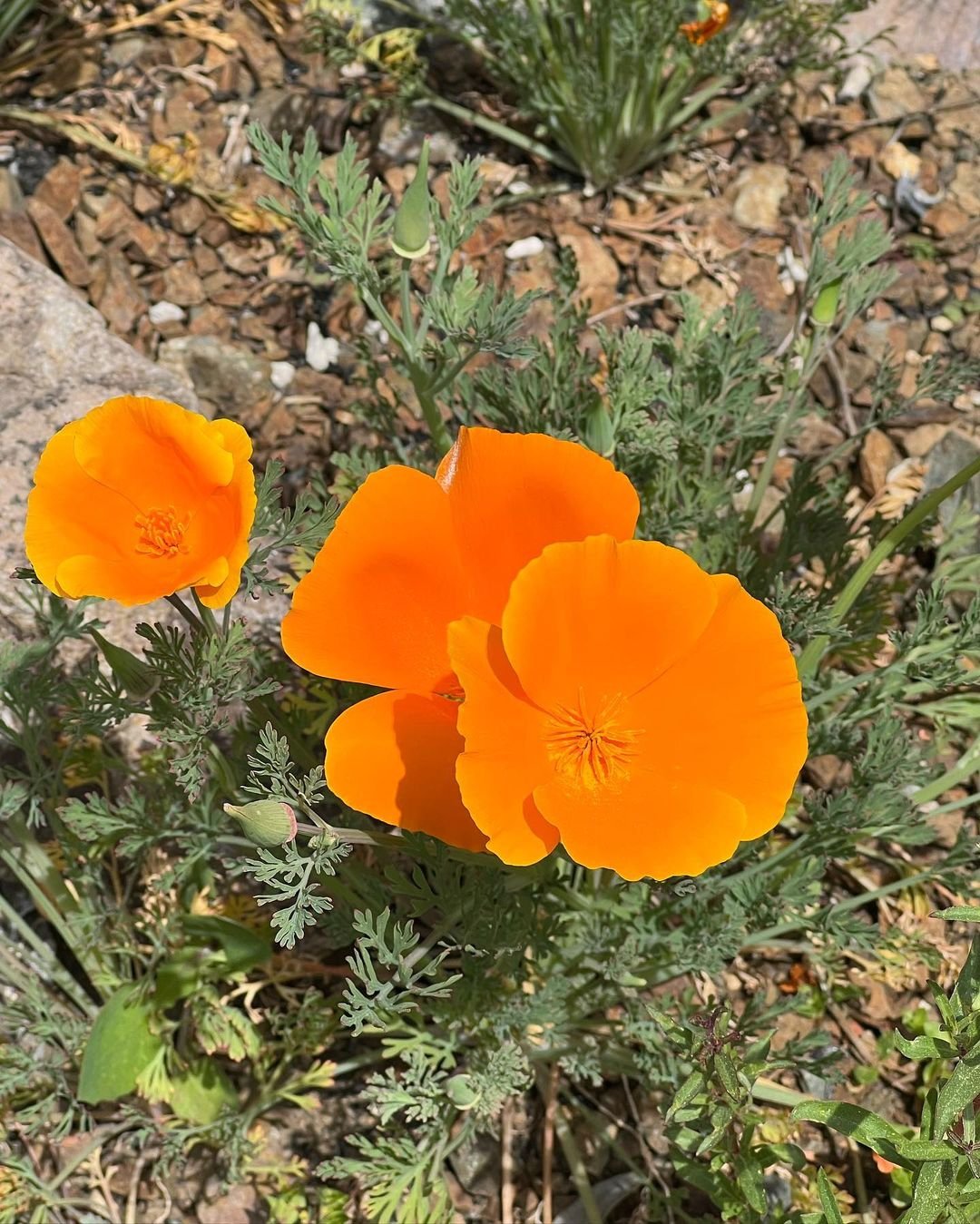
Here’s a detailed short information chart about the California Poppy (Eschscholzia californica):
| Feature | Description |
|---|---|
| Botanical Name | Eschscholzia californica |
| Common Name | California Poppy |
| Plant Type | Herbaceous perennial |
| Family | Papaveraceae |
| Native Range | California and southwestern United States |
| Zones | USDA zones 6-10 |
| Flowers | Cup-shaped, vibrant orange, occasionally yellow or red |
| Sun Exposure | Full sun |
| Soil Type | Well-drained, sandy or loamy soil |
| Watering | Drought tolerant; moderate water needs |
| Growth Habit | Compact, spreading |
| Height/Spread | 12-18 inches (30-45 cm) in height, spreads up to 12 inches (30 cm) |
| Special Features | Drought tolerant; attracts pollinators; state flower of California |
Kicking off our list is the iconic California Poppy. This cheerful annual boasts silky, cup-shaped flowers in shades ranging from golden orange to deep apricot. Easy to grow from seed, California Poppies are perfect for adding a touch of wildflower charm to your garden.
2. Marigold
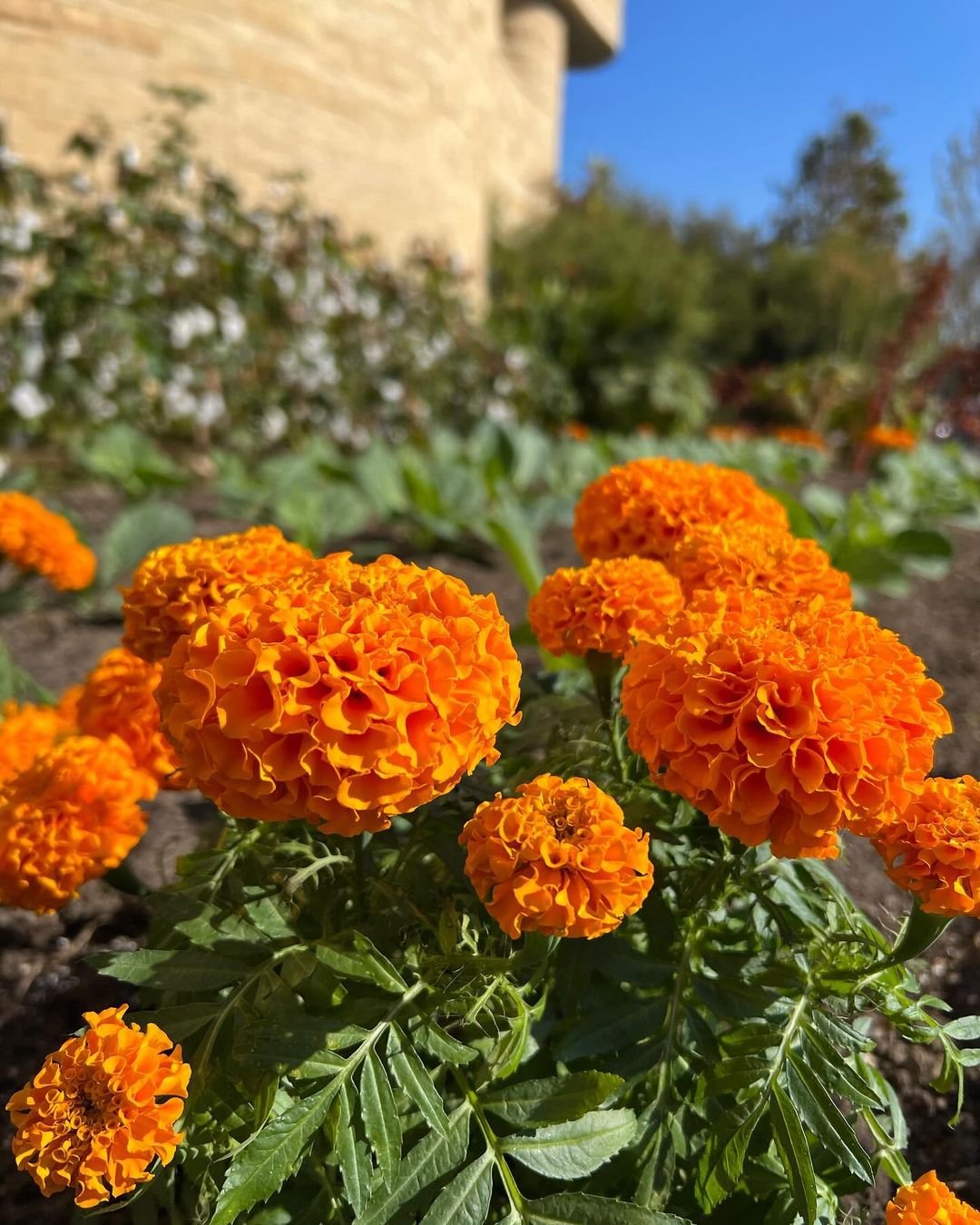
Here’s a short information chart about Marigolds (Tagetes spp.):
| Feature | Description |
|---|---|
| Botanical Name | Tagetes spp. |
| Common Name | Marigold |
| Plant Type | Annual or perennial herbaceous |
| Family | Asteraceae |
| Native Range | Central and South America, Mexico |
| Zones | USDA zones 2-11, depending on species |
| Flowers | Typically orange, yellow, or golden; some species have maroon highlights |
| Sun Exposure | Full sun |
| Soil Type | Well-drained, fertile soil |
| Watering | Moderate; drought tolerant once established |
| Growth Habit | Bushy, compact |
| Height/Spread | 6 inches to 3 feet (15 cm to 90 cm) depending on species |
| Special Features | Pest-repellent properties; used in companion planting; edible flowers in some varieties |
No list of flowers would be complete without the beloved Marigold. These sturdy annuals come in various shades of orange, from pale peach to deep amber. Their pom-pom-like blooms are not only beautiful but also help repel garden pests.
3. Butterfly Weed
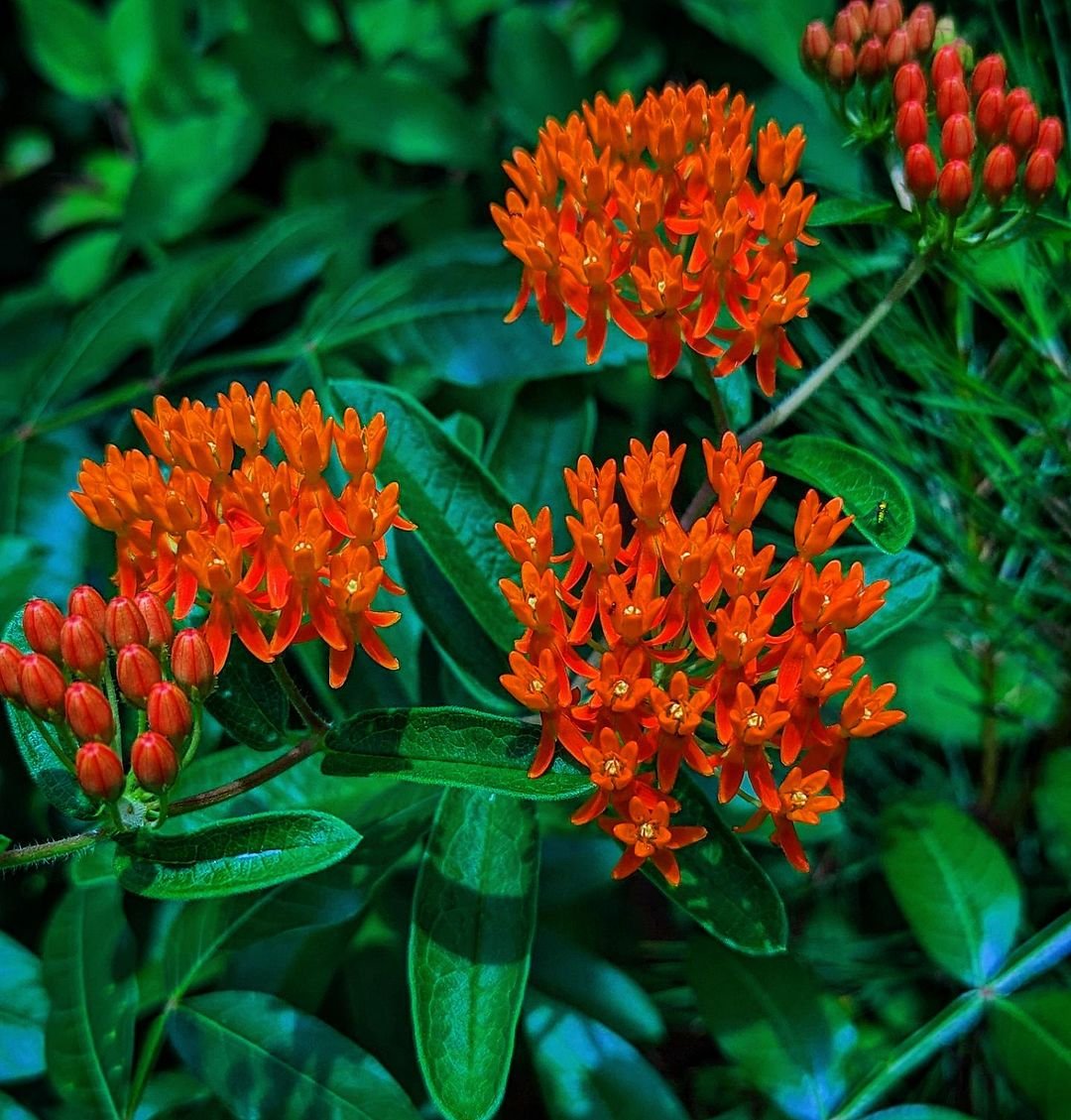
Here’s a short information chart about Butterfly Weed (Asclepias tuberosa):
| Feature | Description |
|---|---|
| Botanical Name | Asclepias tuberosa |
| Common Name | Butterfly Weed |
| Plant Type | Herbaceous perennial |
| Family | Apocynaceae |
| Native Range | Eastern and southwestern United States |
| Zones | USDA zones 4-9 |
| Flowers | Clusters of bright orange to yellow-orange |
| Sun Exposure | Full sun |
| Soil Type | Well-drained, sandy or loamy soil |
| Watering | Drought tolerant; prefers dry to medium moisture |
| Growth Habit | Upright, clump-forming |
| Height/Spread | 1-3 feet (30-90 cm) in height, spreads about 1-2 feet (30-60 cm) |
| Special Features | Attracts butterflies and other pollinators; larval host plant for monarch butterflies; deer resistant |
Also known as orange milkweed, Butterfly Weed is a native perennial that produces clusters of vibrant flowers. As its name suggests, it’s a magnet for butterflies, especially monarchs.
4. Tiger Lily
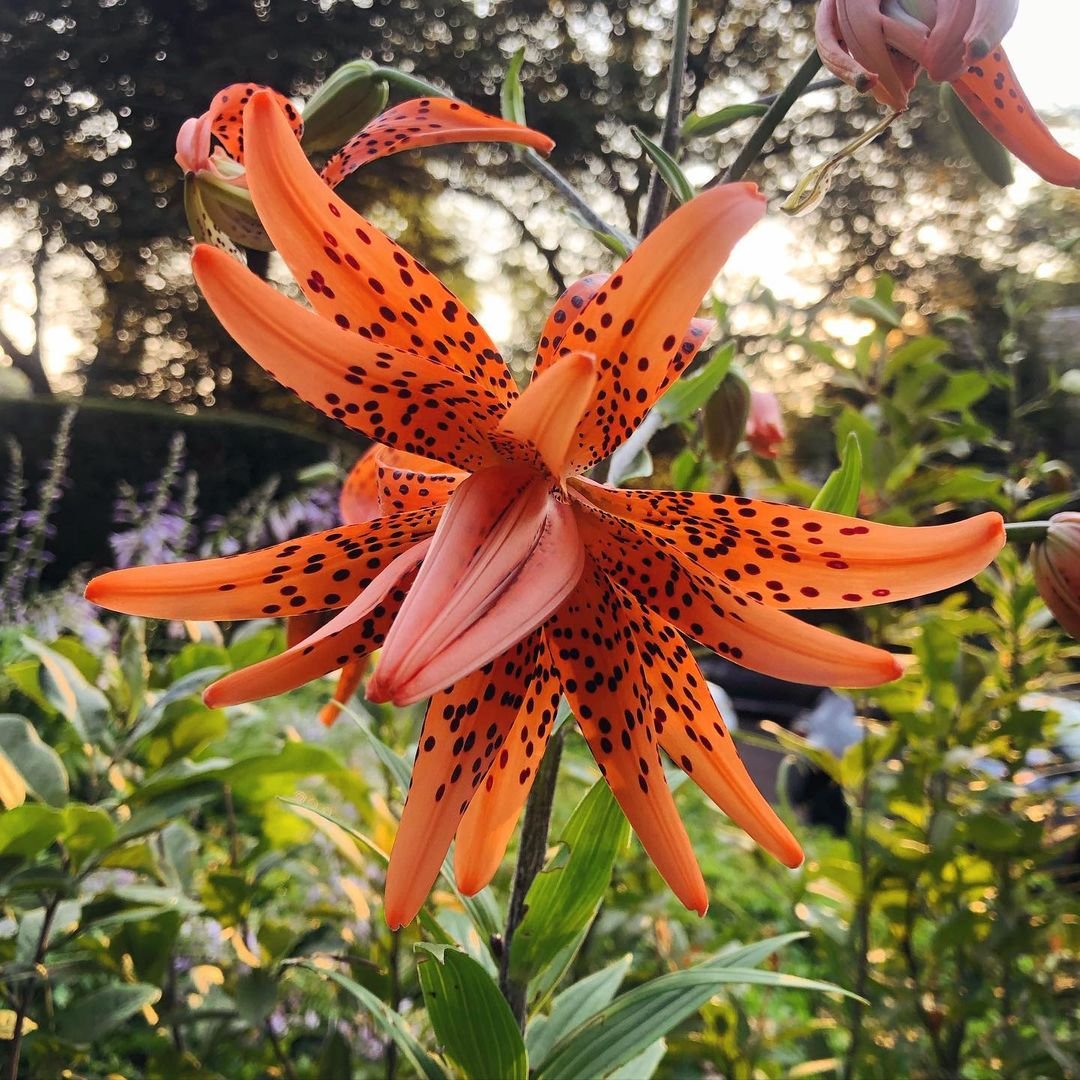
Here’s a short information chart about Tiger Lily (Lilium lancifolium):
| Feature | Description |
|---|---|
| Botanical Name | Lilium lancifolium |
| Common Name | Tiger Lily |
| Plant Type | Herbaceous perennial |
| Family | Liliaceae |
| Native Range | Eastern Asia, including China, Japan, and Korea |
| Zones | USDA zones 4-9 |
| Flowers | Large, trumpet-shaped flowers; orange with dark spots |
| Sun Exposure | Full sun to partial shade |
| Soil Type | Well-drained, fertile soil |
| Watering | Moderate; keep soil evenly moist |
| Growth Habit | Upright, tall |
| Height/Spread | 3-4 feet (90-120 cm) in height, spreads 1-2 feet (30-60 cm) |
| Special Features | Ornamental; attracts pollinators; deer resistant |
The striking Tiger Lily features bold orange petals with dark spots, resembling a tiger’s coat. This perennial bulb adds a touch of exotic beauty to any garden.
5. Zinnia
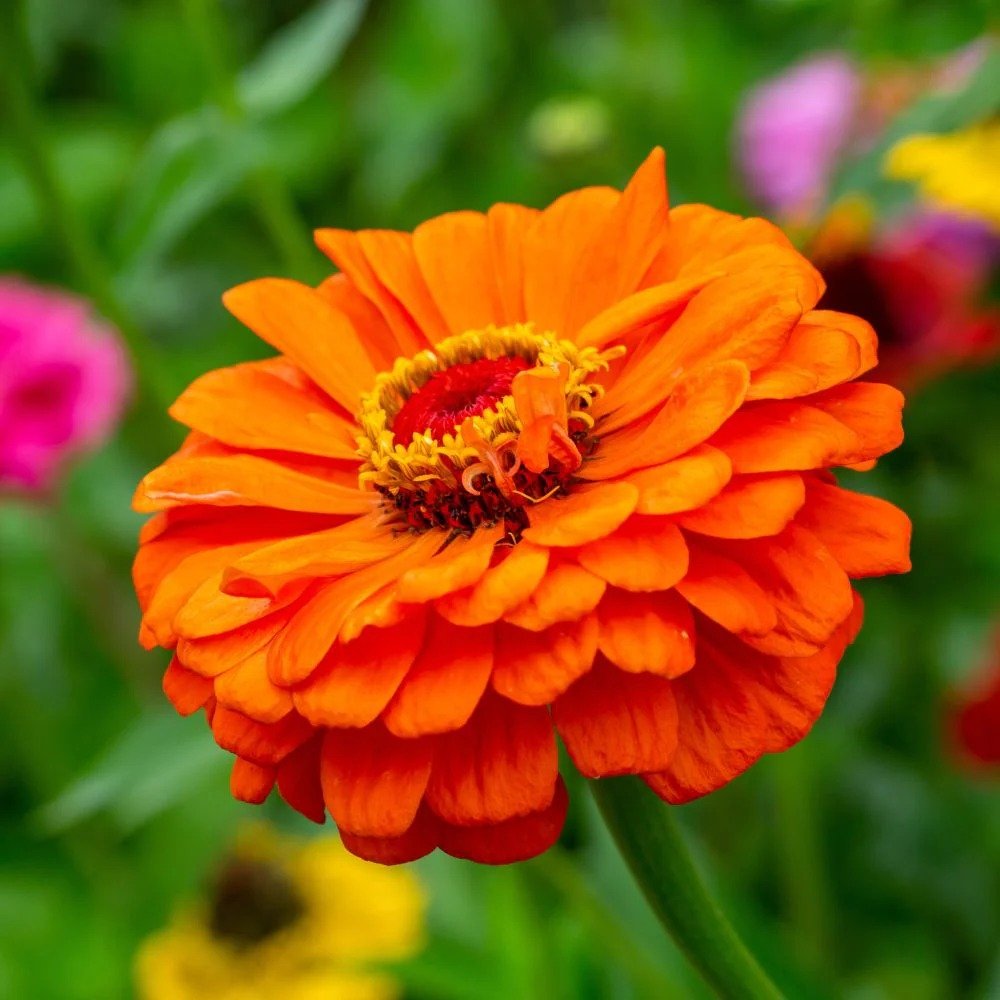
Here’s a concise information chart about Zinnia (Zinnia elegans):
| Feature | Description |
|---|---|
| Botanical Name | Zinnia elegans |
| Common Name | Zinnia |
| Plant Type | Annual |
| Family | Asteraceae |
| Native Range | Mexico, Central America |
| Zones | USDA zones 3-10 |
| Flowers | Wide variety of colors including red, pink, orange, yellow, purple and white; daisy-like, double or single blooms |
| Sun Exposure | Full sun |
| Soil Type | Well-drained, fertile soil |
| Watering | Moderate; drought tolerant once established |
| Growth Habit | Upright, bushy |
| Height/Spread | 6 inches to 3 feet (15 cm to 90 cm) depending on variety |
| Special Features | Attracts butterflies and pollinators; excellent for cut flowers; low maintenance |
Zinnias are easy-to-grow annuals that come in a variety of orange hues. Their daisy-like flowers bloom profusely throughout summer, making them perfect for cutting gardens.
6. Daylily
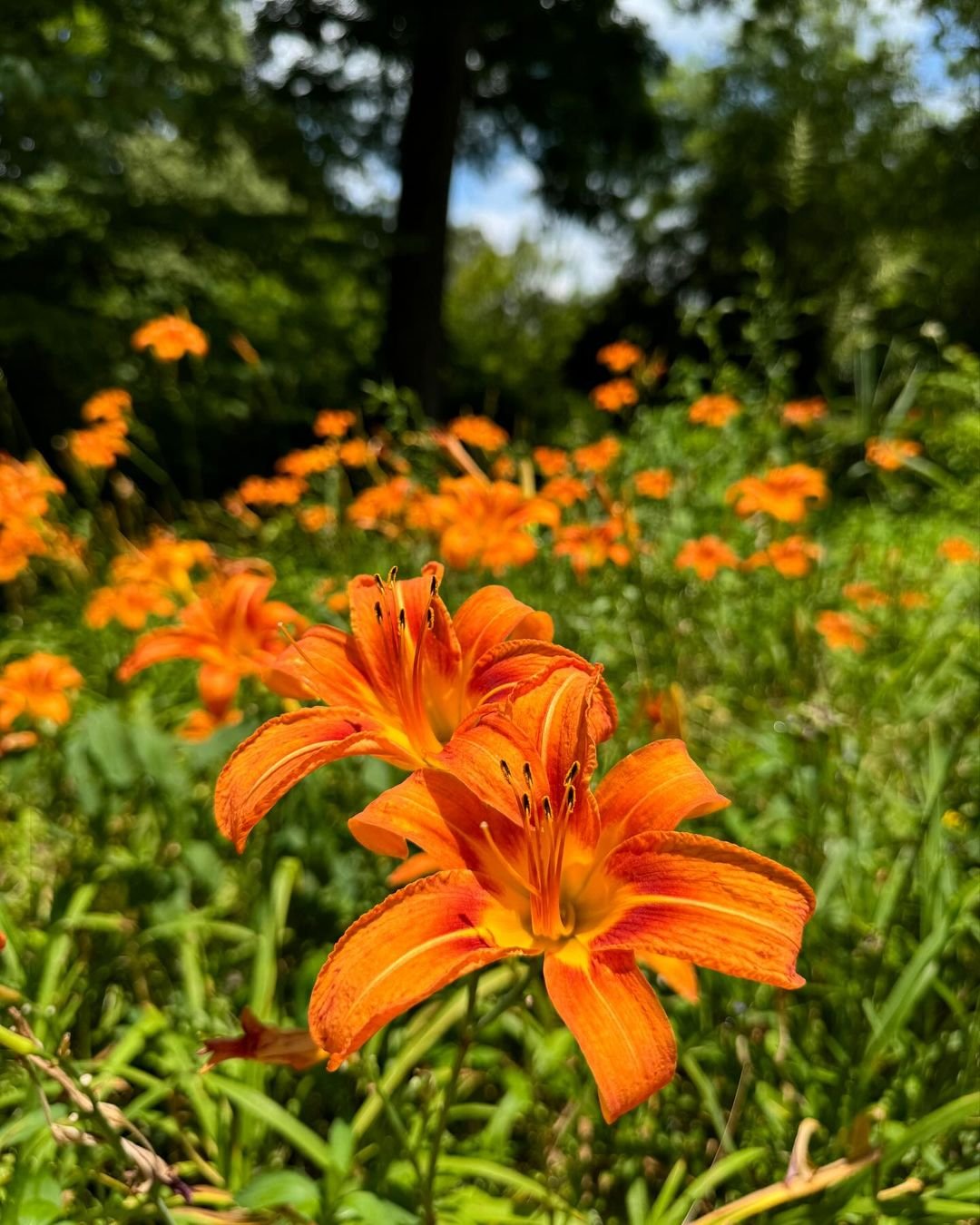
Here’s a short information chart about Daylilies (Hemerocallis spp.):
| Feature | Description |
|---|---|
| Botanical Name | Hemerocallis spp. |
| Common Name | Daylily |
| Plant Type | Herbaceous perennial |
| Family | Asphodelaceae (formerly Liliaceae) |
| Native Range | Eastern Asia |
| Zones | USDA zones 3-9, depending on the species |
| Flowers | Large, trumpet-shaped flowers; various colors including yellow, orange, red, pink, and bi-colors |
| Sun Exposure | Full sun to part shade |
| Soil Type | Well-drained, fertile soil |
| Watering | Moderate; keep soil evenly moist |
| Growth Habit | Clumping, grass-like foliage |
| Height/Spread | 1-4 feet (30-120 cm) in height, spreads 1-3 feet (30-90 cm) |
| Special Features | Long blooming season; attracts butterflies; deer resistant |
Daylilies are hardy perennials that offer a wide range of orange shades. From soft peach to fiery red-orange, there’s a daylily to suit every taste.
7. Nasturtium
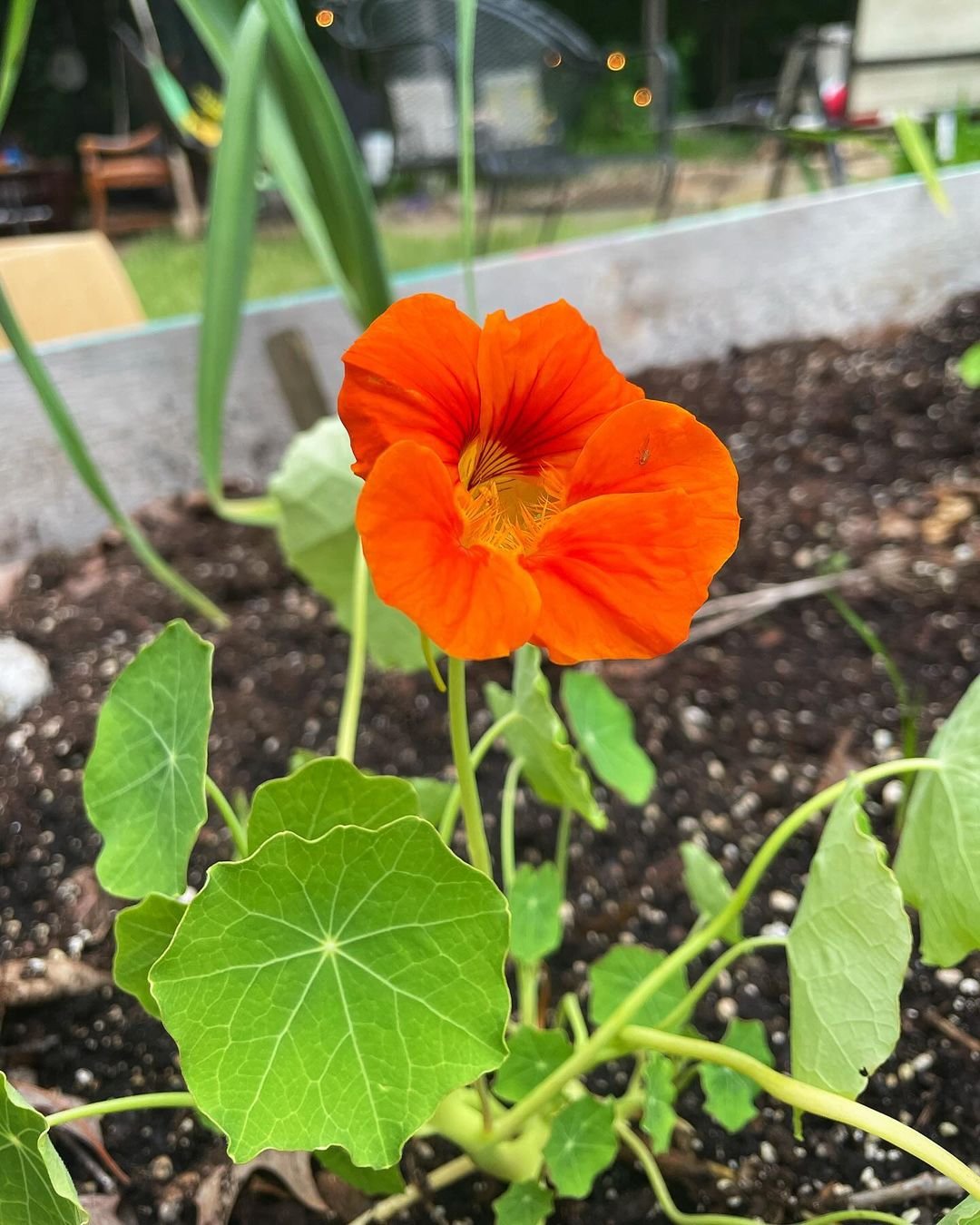
Here’s a short information chart about Nasturtium (Tropaeolum majus):
| Feature | Description |
|---|---|
| Botanical Name | Tropaeolum majus |
| Common Name | Nasturtium |
| Plant Type | Annual |
| Family | Tropaeolaceae |
| Native Range | South America |
| Zones | USDA zones 9-11 |
| Flowers | Brightly colored, trumpet-shaped flowers in shades of red, orange, yellow, and peach |
| Sun Exposure | Full sun |
| Soil Type | Well-drained, fertile soil |
| Watering | Moderate; drought tolerant |
| Growth Habit | Spreading, trailing |
| Height/Spread | 6-12 inches (15-30 cm) in height, spreads up to 2 feet (60 cm) |
| Special Features | Edible flowers and leaves; attracts pollinators; deer resistant |
The Nasturtium is a versatile annual with edible flowers and leaves. Its bright orange blooms add a peppery flavor to salads and a cheerful touch to gardens.
8. Coneflower
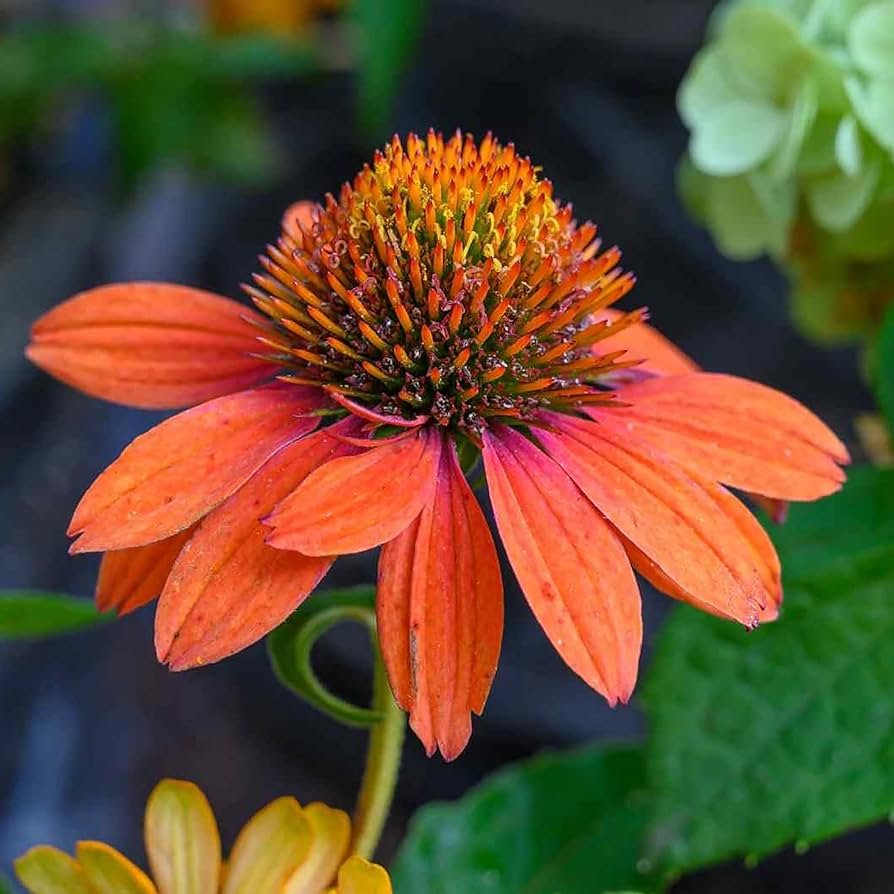
Here’s a short information chart about Coneflower (Echinacea ‘Flame Thrower’):
| Feature | Description |
|---|---|
| Botanical Name | Echinacea purpurea ‘Flame Thrower’ |
| Common Name | Coneflower |
| Plant Type | Herbaceous perennial |
| Family | Asteraceae |
| Native Range | North America, primarily central and eastern regions |
| Zones | USDA zones 4-9 |
| Flowers | Large, daisy-like flowers with bright orange-red petals and a prominent cone center |
| Sun Exposure | Full sun |
| Soil Type | Well-drained, fertile soil |
| Watering | Moderate; drought tolerant once established |
| Growth Habit | Upright, clumping |
| Height/Spread | 18-24 inches (45-60 cm) in height, spreads 12-18 inches (30-45 cm) |
| Special Features | Attracts pollinators; deer resistant; vibrant, unique flower color |
While most people think of purple when they hear coneflower, the ‘Flame Thrower’ variety offers stunning orange petals surrounding a dark center cone.
9. Dahlia
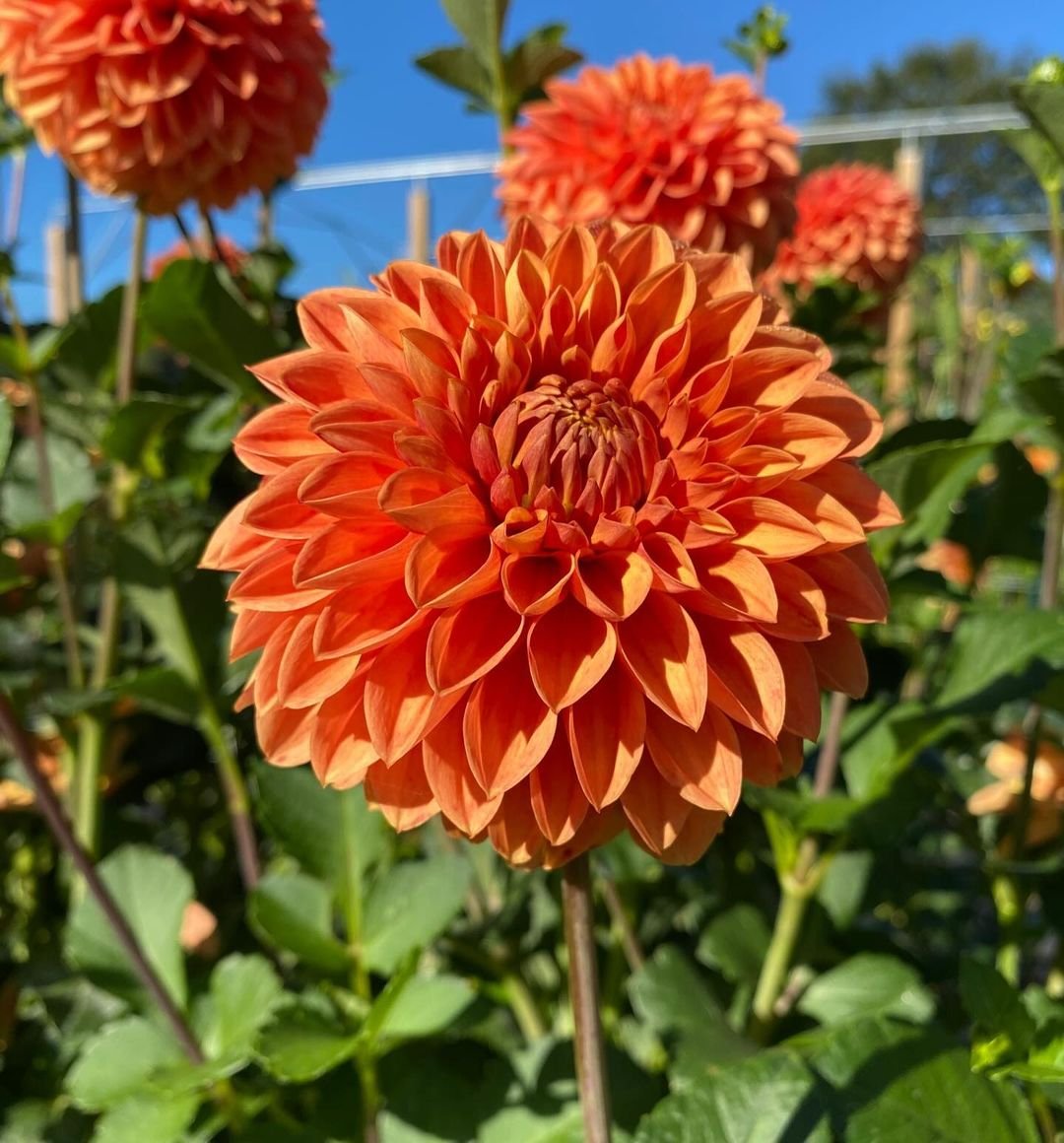
Here’s a short information chart about Dahlias (Dahlia spp.):
| Feature | Description |
|---|---|
| Botanical Name | Dahlia spp. |
| Common Name | Dahlia |
| Plant Type | Tuberous perennial |
| Family | Asteraceae |
| Native Range | Mexico, Central America |
| Zones | USDA zones 8-11, depending on species |
| Flowers | Large, showy flowers in a wide range of colors including white, yellow, orange, pink, red, and purple; various shapes and sizes |
| Sun Exposure | Full sun |
| Soil Type | Well-drained, fertile soil |
| Watering | Moderate; keep soil evenly moist |
| Growth Habit | Upright, bushy |
| Height/Spread | 1-6 feet (30 cm to 1.8 m) in height, depending on variety |
| Special Features | Excellent for cut flowers; attracts pollinators; wide variety of forms and colors |
Dahlias come in a wide array of shapes and sizes, with many varieties featuring beautiful orange blooms. From small pompoms to dinner-plate sized flowers, there’s a dahlia for every garden style.
10. Calendula
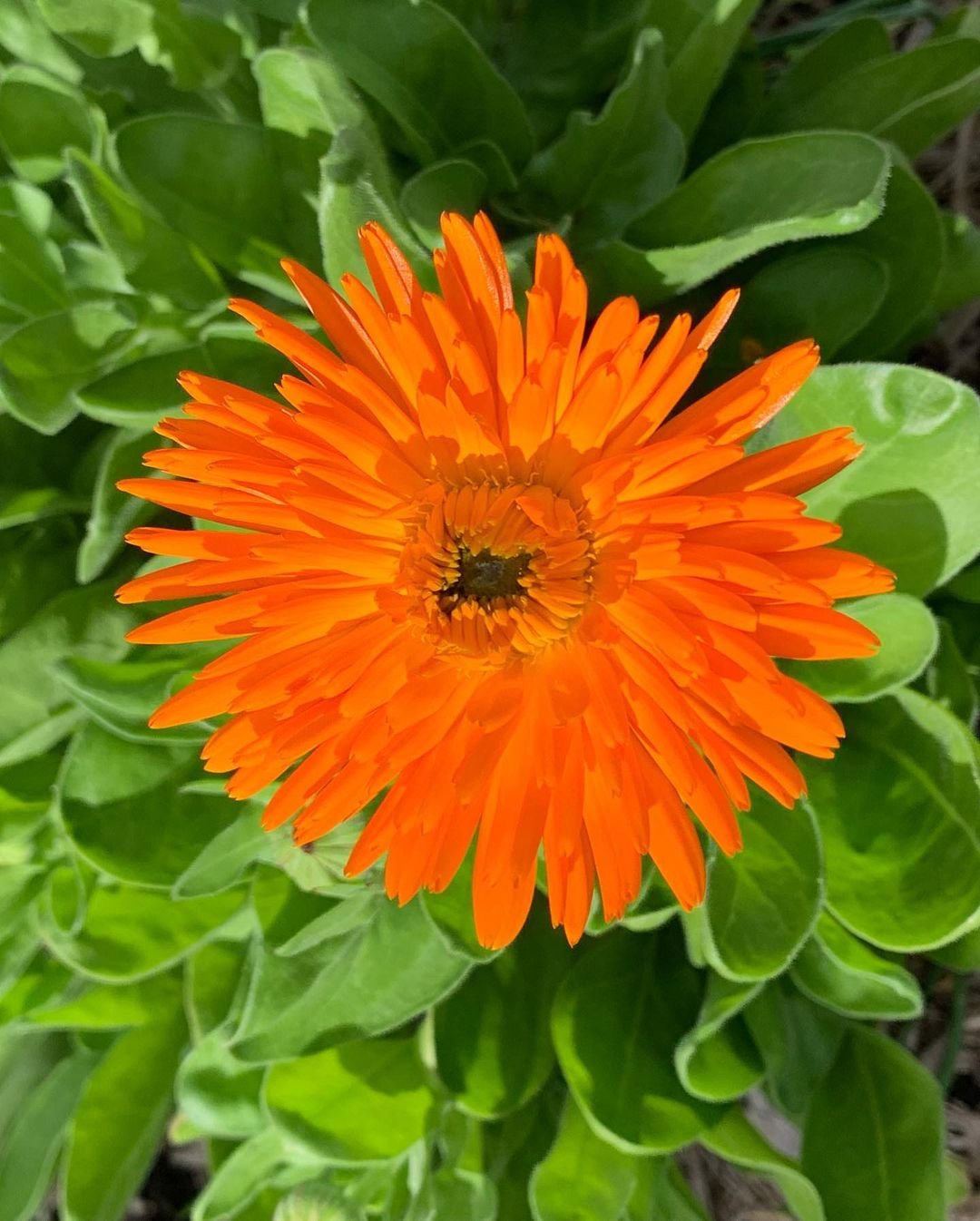
Here’s a short information chart about Calendula (Calendula officinalis):
| Feature | Description |
|---|---|
| Botanical Name | Calendula officinalis |
| Common Name | Calendula, Pot Marigold |
| Plant Type | Annual |
| Family | Asteraceae |
| Native Range | Southern Europe, Mediterranean |
| Zones | USDA zones 2-11, depending on the species |
| Flowers | Bright, daisy-like flowers in shades of yellow and orange; some varieties may have apricot or cream colors |
| Sun Exposure | Full sun to part shade |
| Soil Type | Well-drained, fertile soil |
| Watering | Moderate; drought tolerant |
| Growth Habit | Upright, bushy |
| Height/Spread | 1-2 feet (30-60 cm) in height, spreads up to 1 foot (30 cm) |
| Special Features | Edible flowers; medicinal herb; attracts pollinators; deer resistant |
Also known as pot marigold, Calendula offers cheery Orange Colours that bloom from spring through fall. It’s not only beautiful but also has medicinal properties.
11. Trumpet Vine
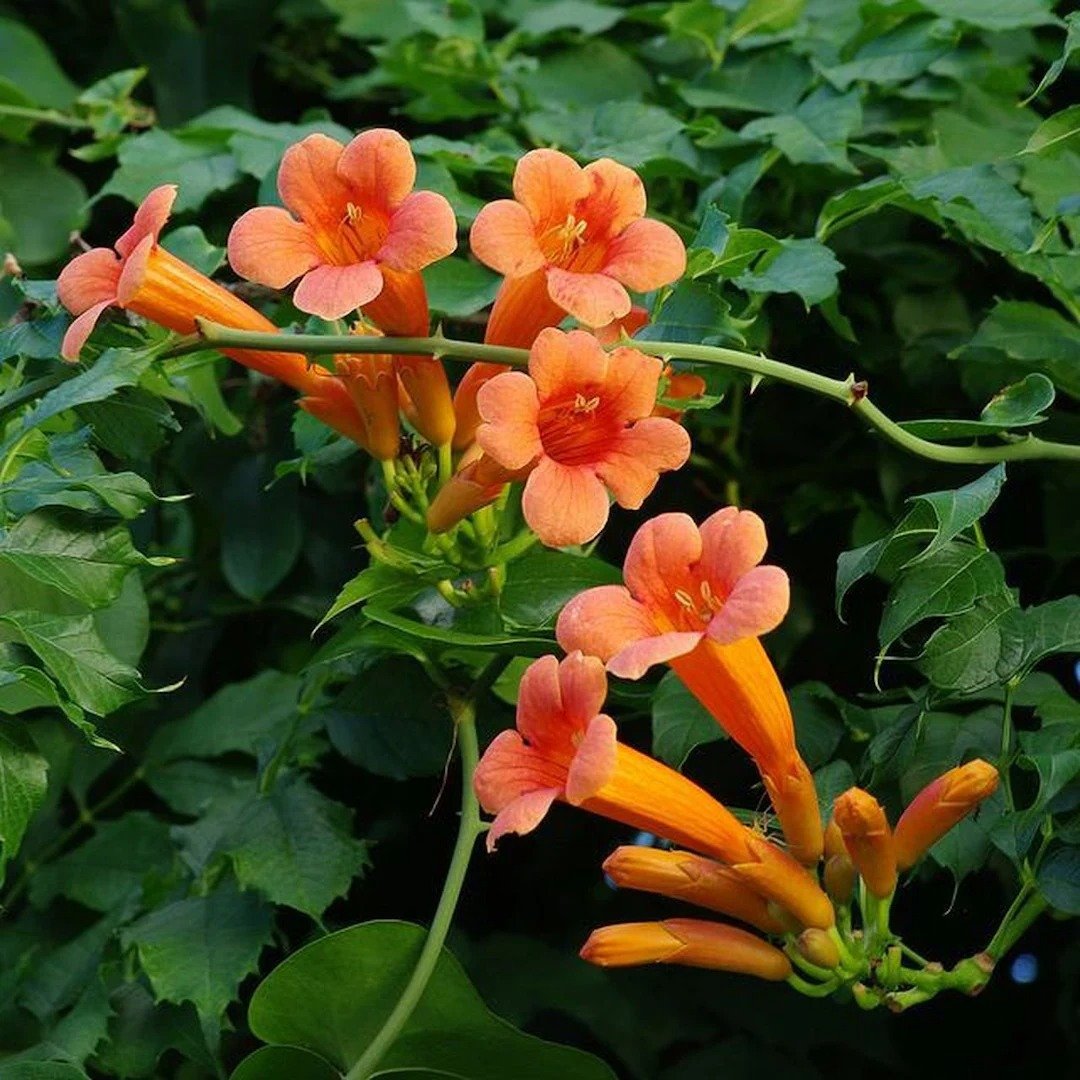
Here’s a short information chart about Trumpet Vine (Campsis radicans):
| Feature | Description |
|---|---|
| Botanical Name | Campsis radicans |
| Common Name | Trumpet Vine, Trumpet Creeper |
| Plant Type | Deciduous vine |
| Family | Bignoniaceae |
| Native Range | Eastern United States, Mexico |
| Zones | USDA zones 4-9 |
| Flowers | Large, trumpet-shaped flowers in shades of orange to red; blooms appear in clusters |
| Sun Exposure | Full sun to part shade |
| Soil Type | Well-drained soil |
| Watering | Moderate; drought tolerant once established |
| Growth Habit | Vigorous climbing vine |
| Height/Spread | Can reach up to 30 feet (9 meters) in height, spreads 5-10 feet (1.5-3 meters) |
| Special Features | Attracts hummingbirds; fast-growing; can be invasive in some regions |
The Trumpet Vine is a fast-growing climber that produces clusters of tubular flowers. It’s perfect for covering fences or arbors.
12. Bird of Paradise
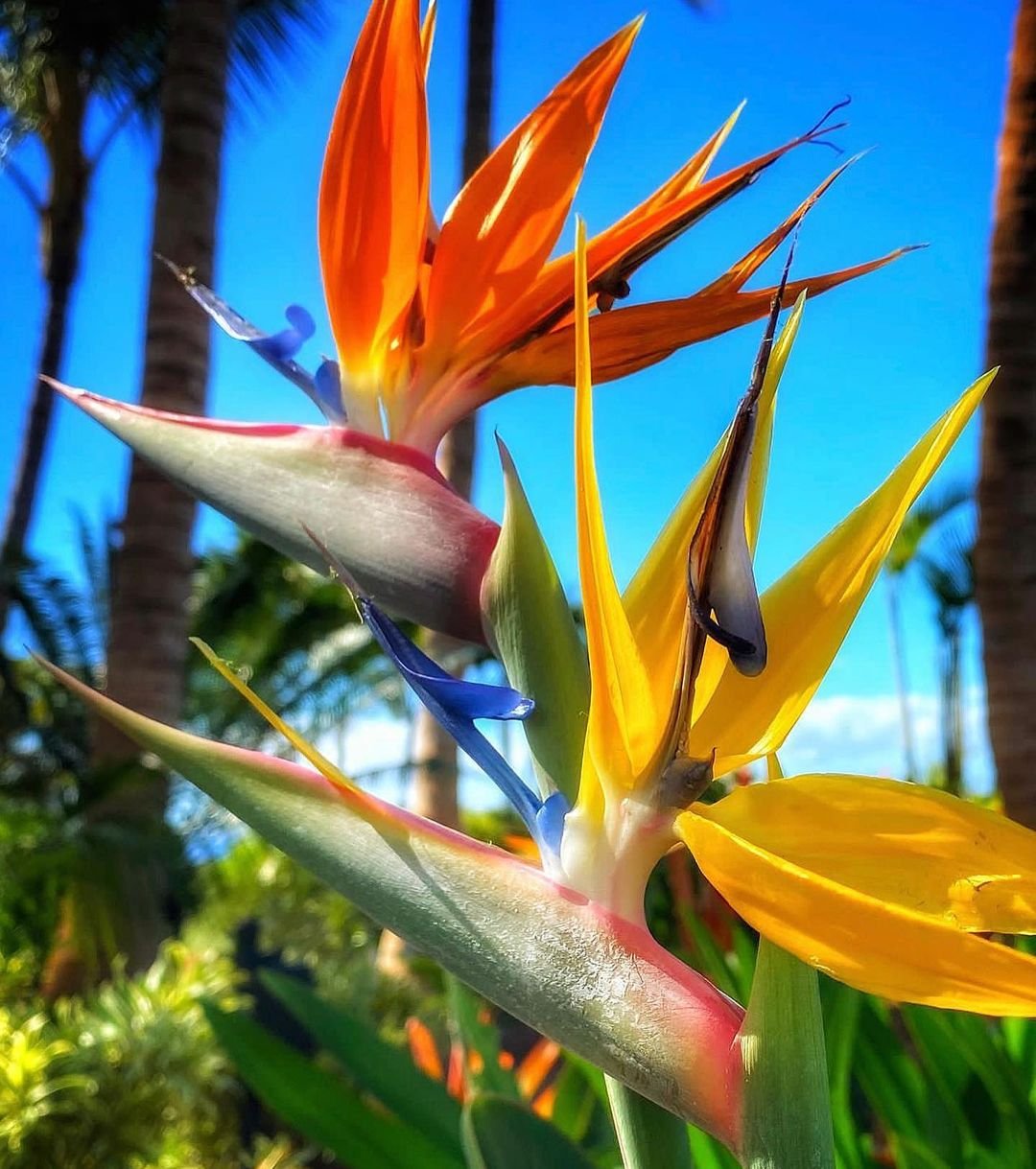
Here’s a short information chart about Bird of Paradise (Strelitzia reginae):
| Feature | Description |
|---|---|
| Botanical Name | Strelitzia reginae |
| Common Name | Bird of Paradise |
| Plant Type | Evergreen perennial |
| Family | Strelitziaceae |
| Native Range | South Africa |
| Zones | USDA zones 9-11 |
| Flowers | Distinctive bird-like orange and blue flowers; bloom resembles a bird in flight |
| Sun Exposure | Full sun to part shade |
| Soil Type | Well-drained, fertile soil |
| Watering | Moderate; drought tolerant once established |
| Growth Habit | Clumping, upright |
| Height/Spread | 3-5 feet (1-1.5 meters) in height, spreads 2-3 feet (60-90 cm) |
| Special Features | Unique flower shape; tropical appearance; popular as cut flowers |
For a tropical touch, consider the Bird of Paradise. Its unique orange and blue flowers resemble exotic birds in flight.
13. Begonia
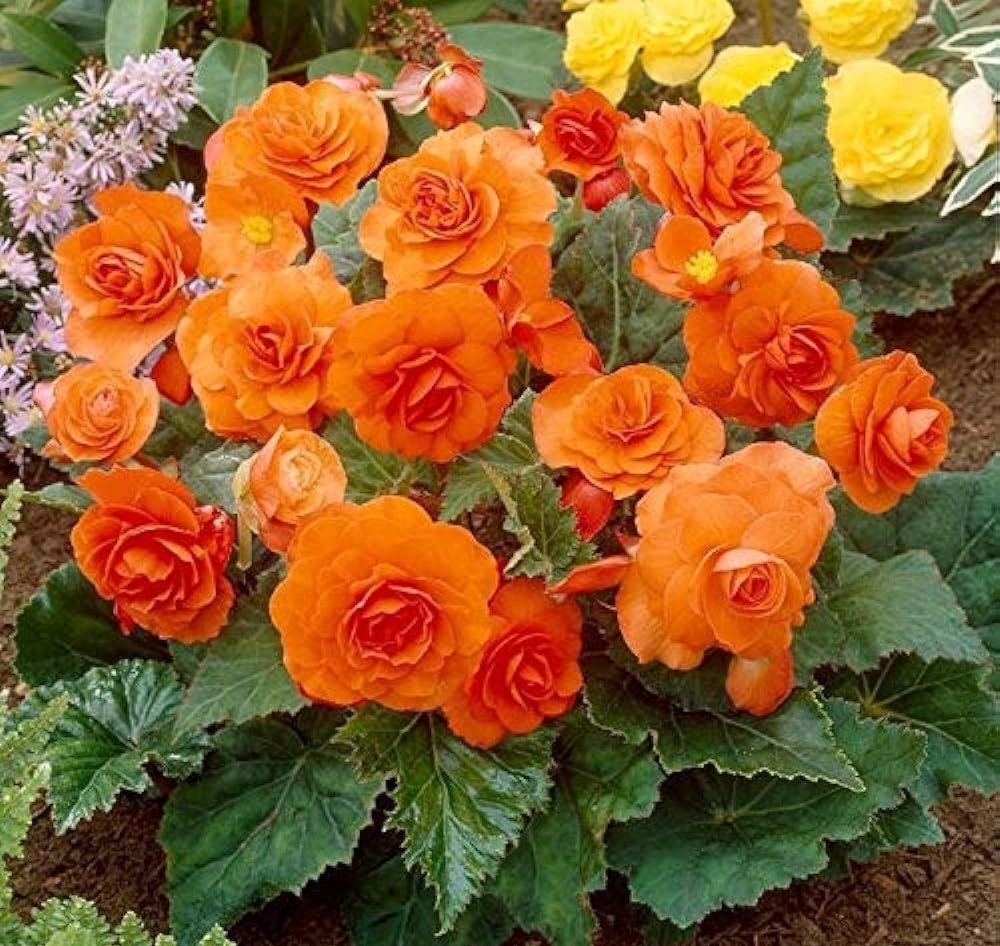
Here’s a concise information chart about Begonia (Begonia spp.):
| Aspect | Information |
|---|---|
| Botanical Name | Begonia spp. |
| Common Name | Begonia |
| Plant Type | Herbaceous perennial |
| Family | Begoniaceae |
| Native Range | Tropical and subtropical regions worldwide |
| Zones | Typically zones 10-11, can be grown as annuals elsewhere |
| Flowers | Showy, often in shades of pink, red, white, or orange |
| Sun Exposure | Bright, indirect light to partial shade |
| Soil Type | Well-draining, rich in organic matter |
| Watering | Regular, allowing soil to dry slightly between waterings |
| Growth Habit | Upright or trailing, depending on species |
| Height/Spread | Varies widely by species; typically 6 inches to 2 feet |
| Special Features | Colorful foliage, variety of flower shapes and colors |
Many Begonia varieties offer beautiful orange blooms. These versatile plants work well in both garden beds and containers.
14. Blanket Flower
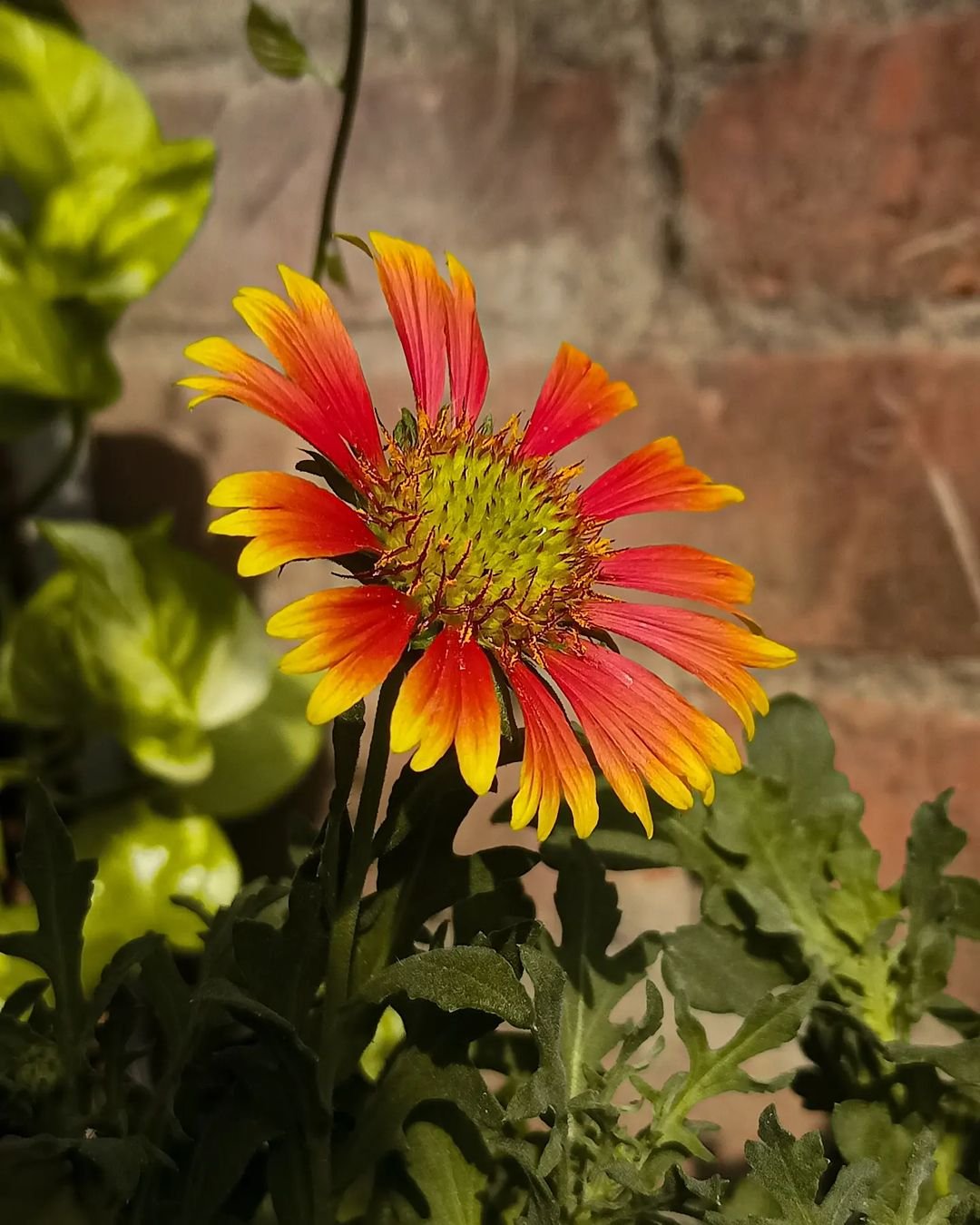
Here’s a short information chart for Blanket Flower (Gaillardia spp.):
| Aspect | Information |
|---|---|
| Botanical Name | Gaillardia spp. |
| Common Name | Blanket Flower |
| Plant Type | Herbaceous perennial |
| Family | Asteraceae |
| Native Range | North and South America |
| Zones | Typically zones 3-10 |
| Flowers | Daisy-like, vibrant colors (red, yellow, orange) |
| Sun Exposure | Full sun |
| Soil Type | Well-drained, sandy to loamy soil |
| Watering | Moderate; drought tolerant once established |
| Growth Habit | Compact mound, spreading |
| Height/Spread | 1 to 2 feet tall, 1 to 1.5 feet wide |
| Special Features | Attracts pollinators (bees, butterflies), long blooming season |
Blanket Flowers produce daisy-like blooms in shades of orange, red and yellow. They’re drought-tolerant and attract butterflies.
15. Canna Lily
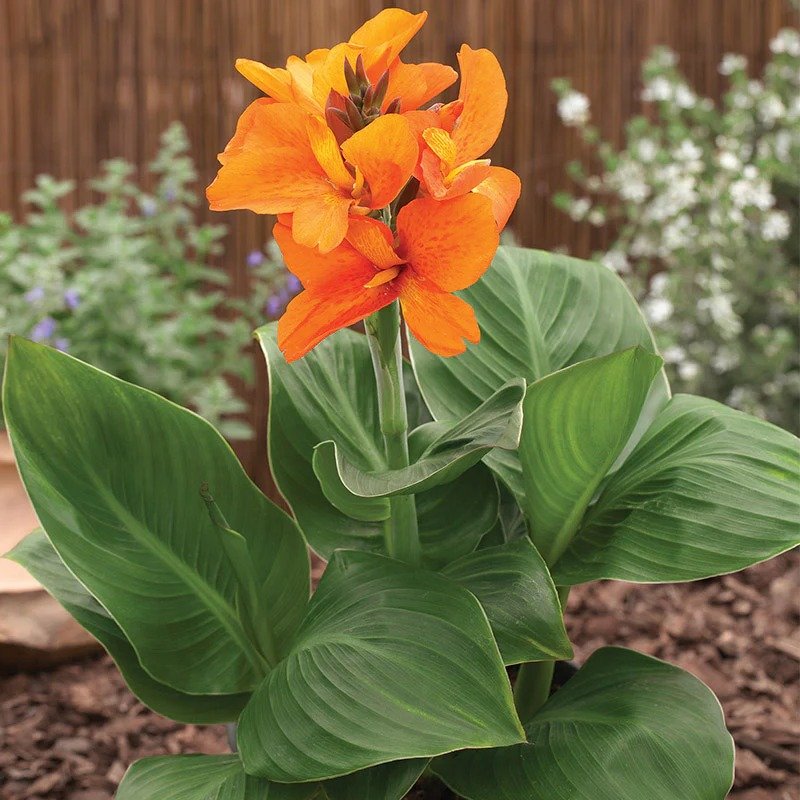
Here’s a short information chart for Canna Lily (Canna spp.):
| Aspect | Information |
|---|---|
| Botanical Name | Canna spp. |
| Common Name | Canna Lily |
| Plant Type | Herbaceous perennial |
| Family | Cannaceae |
| Native Range | Tropical and subtropical regions worldwide |
| Zones | Typically zones 8-11 |
| Flowers | Large, showy flowers in various colors (red, yellow, pink, orange) |
| Sun Exposure | Full sun to part shade |
| Soil Type | Rich, moist, well-draining soil |
| Watering | Regular; keep soil consistently moist |
| Growth Habit | Upright, clumping |
| Height/Spread | 3 to 8 feet tall, 1 to 3 feet wide |
| Special Features | Tropical foliage, attracts hummingbirds, rhizomatous roots |
Canna Lilies offer bold, tropical foliage topped with spikes of flowers. They’re perfect for adding height and drama to garden beds.
16. Cosmos
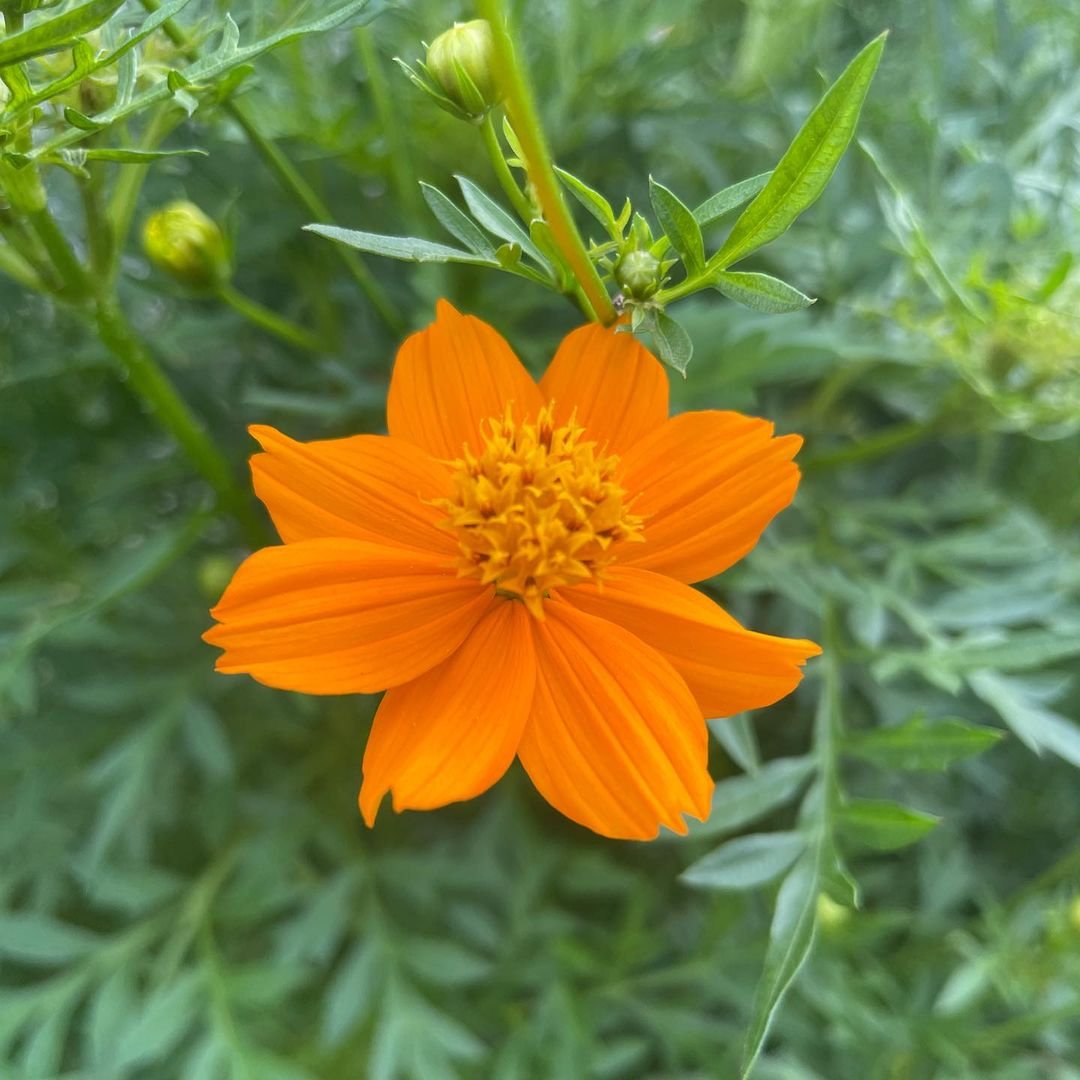
Here’s a short information chart for Cosmos (Cosmos sulphureus):
| Aspect | Information |
|---|---|
| Botanical Name | Cosmos sulphureus |
| Common Name | Cosmos |
| Plant Type | Annual |
| Family | Asteraceae |
| Native Range | Native to Mexico and Central America |
| Zones | Typically grown as annuals, suitable for zones 2-11 |
| Flowers | Daisy-like flowers in shades of yellow, orange, and red |
| Sun Exposure | Full sun |
| Soil Type | Well-drained, average fertility |
| Watering | Moderate; drought tolerant once established |
| Growth Habit | Upright, bushy |
| Height/Spread | 1 to 4 feet tall, 1 to 2 feet wide |
| Special Features | Easy to grow, attracts butterflies and pollinators, long blooming season |
The Cosmos is an easy-to-grow annual that produces masses of orange daisy-like flowers. It’s great for attracting pollinators.
17. Crocosmia
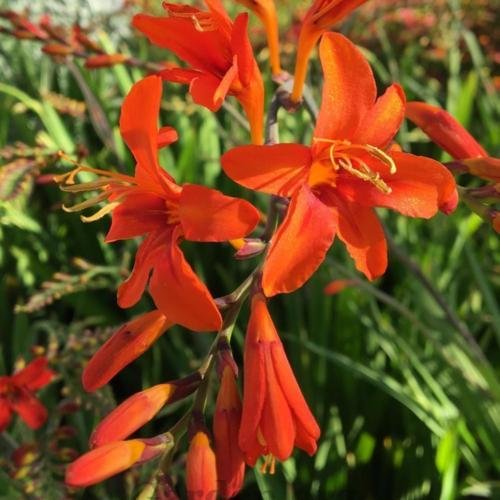
Here’s a short information chart for Crocosmia (Crocosmia spp.):
| Aspect | Information |
|---|---|
| Botanical Name | Crocosmia spp. |
| Common Name | Crocosmia |
| Plant Type | Herbaceous perennial |
| Family | Iridaceae |
| Native Range | Southern and eastern Africa, Madagascar |
| Zones | Typically zones 6-9 |
| Flowers | Trumpet-shaped flowers in shades of red, orange, yellow |
| Sun Exposure | Full sun to partial shade |
| Soil Type | Moist, well-drained soil |
| Watering | Regular watering during growth, less in dormancy |
| Growth Habit | Clumping, upright growth |
| Height/Spread | 1 to 4 feet tall, 1 to 2 feet wide |
| Special Features | Attracts hummingbirds, deer resistant, excellent cut flowers |
Crocosmia features sword-like foliage and arching stems of funnel-shaped flowers. It adds a touch of exotic charm to any garden.
18. Lantana
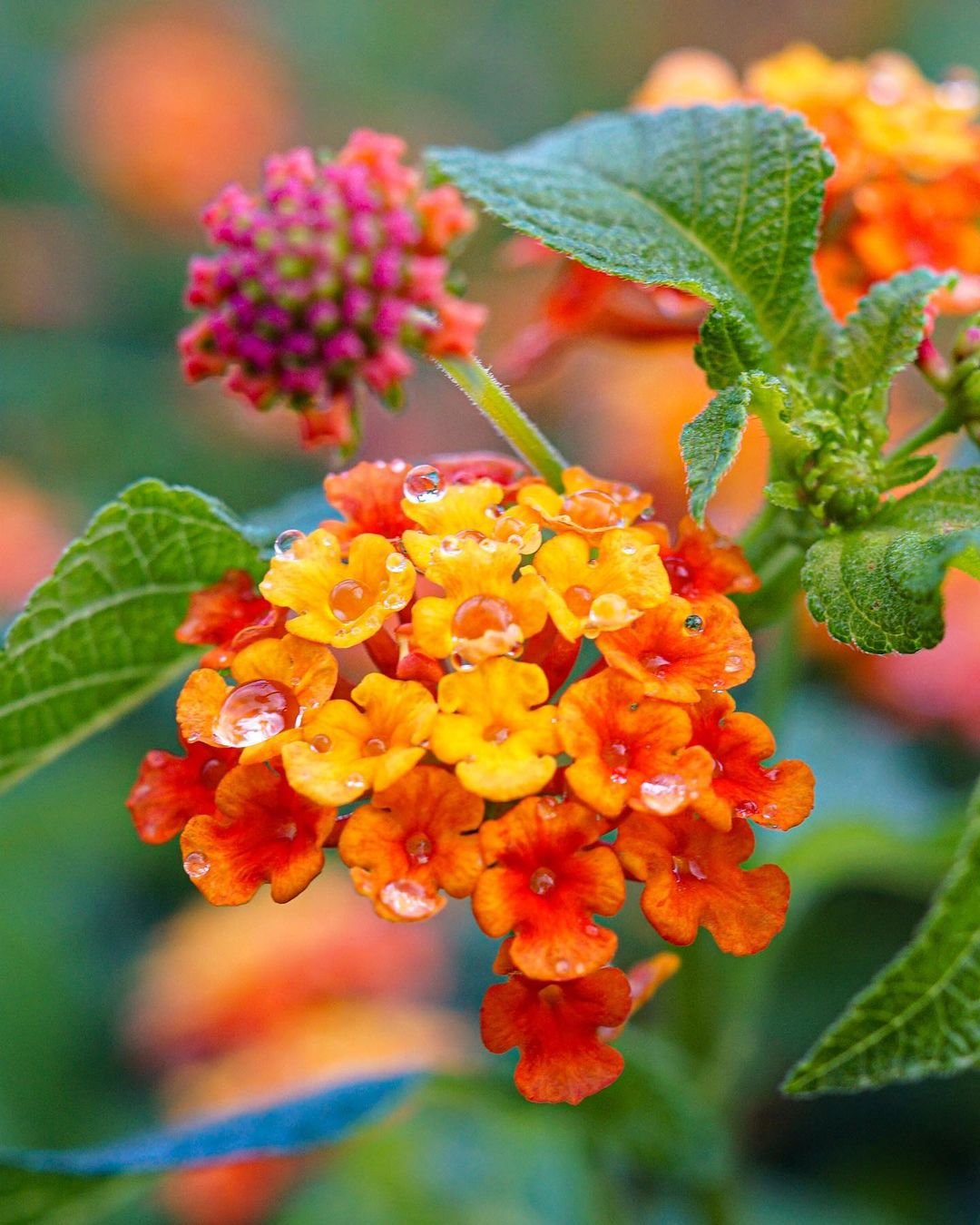
Here’s a short information chart for Lantana (Lantana camara):
| Aspect | Information |
|---|---|
| Botanical Name | Lantana camara |
| Common Name | Lantana |
| Plant Type | Perennial shrub or annual |
| Family | Verbenaceae |
| Native Range | Tropical regions of the Americas |
| Zones | Typically zones 8-11, grown as annuals in colder zones |
| Flowers | Small, clustered flowers in various colors (red, orange, yellow, pink) |
| Sun Exposure | Full sun to part shade |
| Soil Type | Well-drained, fertile soil |
| Watering | Moderate; drought tolerant once established |
| Growth Habit | Upright, spreading |
| Height/Spread | 1 to 6 feet tall, 1 to 5 feet wide |
| Special Features | Attracts butterflies, deer resistant, heat and drought tolerant |
Lantana is a heat-loving plant that produces clusters of small, multicolored flowers, often featuring shades of orange. It’s a favorite of butterflies and hummingbirds.
19. Gladiolus
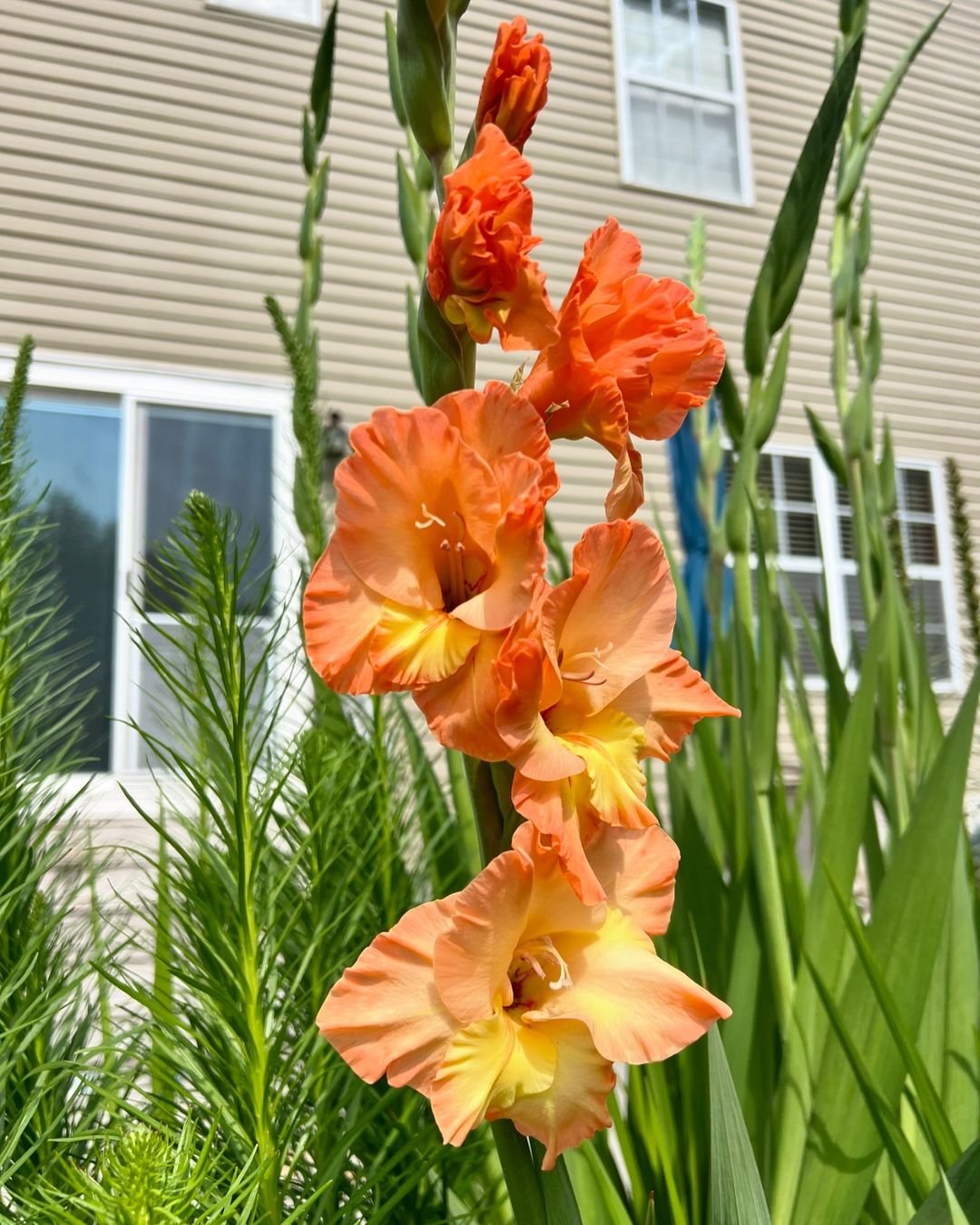
Here’s a short information chart for Gladiolus (Gladiolus spp.):
| Aspect | Information |
|---|---|
| Botanical Name | Gladiolus spp. |
| Common Name | Gladiolus, Sword Lily |
| Plant Type | Cormous perennial |
| Family | Iridaceae |
| Native Range | Southern Africa, Mediterranean region |
| Zones | Typically zones 7-10 |
| Flowers | Spike of funnel-shaped flowers in various colors (red, Orange, pink, yellow, white) |
| Sun Exposure | Full sun |
| Soil Type | Well-drained, fertile soil |
| Watering | Moderate; keep soil evenly moist during active growth |
| Growth Habit | Upright, tall spikes |
| Height/Spread | 2 to 5 feet tall, 1 to 1.5 feet wide |
Many Gladiolus varieties offer stunning orange spikes of flowers. These tall, dramatic plants are perfect for the back of a border.
20. Impatiens
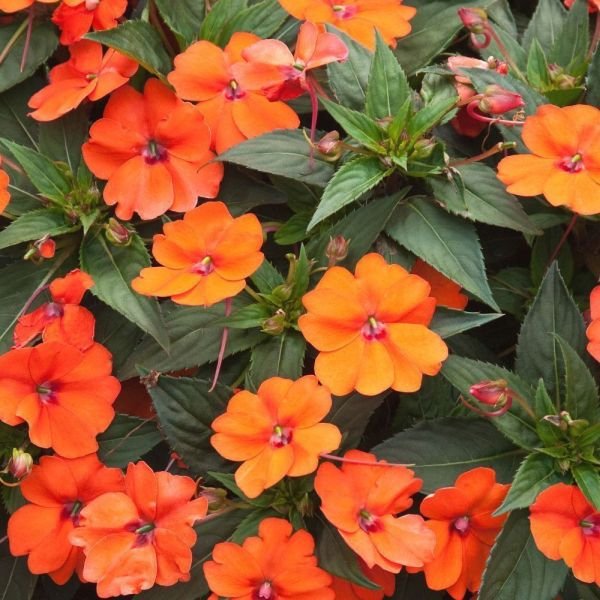
Here’s a short information chart for Impatiens (Impatiens walleriana):
| Aspect | Information |
|---|---|
| Botanical Name | Impatiens walleriana |
| Common Name | Impatiens, Busy Lizzie |
| Plant Type | Herbaceous annual |
| Family | Balsaminaceae |
| Native Range | Eastern Africa |
| Zones | Typically grown as annuals in cooler climates |
| Flowers | Small, single or double flowers in various colors (pink, orange, red, white, purple) |
| Sun Exposure | Part shade to full shade |
| Soil Type | Moist, well-drained soil |
| Watering | Regular; prefers consistently moist soil |
| Growth Habit | Compact, mounding |
| Height/Spread | 6 inches to 2 feet tall, 6 inches to 1.5 feet wide |
| Special Features | Shade-loving, continuous blooming, attracts pollinators |
For shady spots, consider orange Impatiens. These low-growing plants bloom profusely throughout the summer.
21. Mexican Sunflower
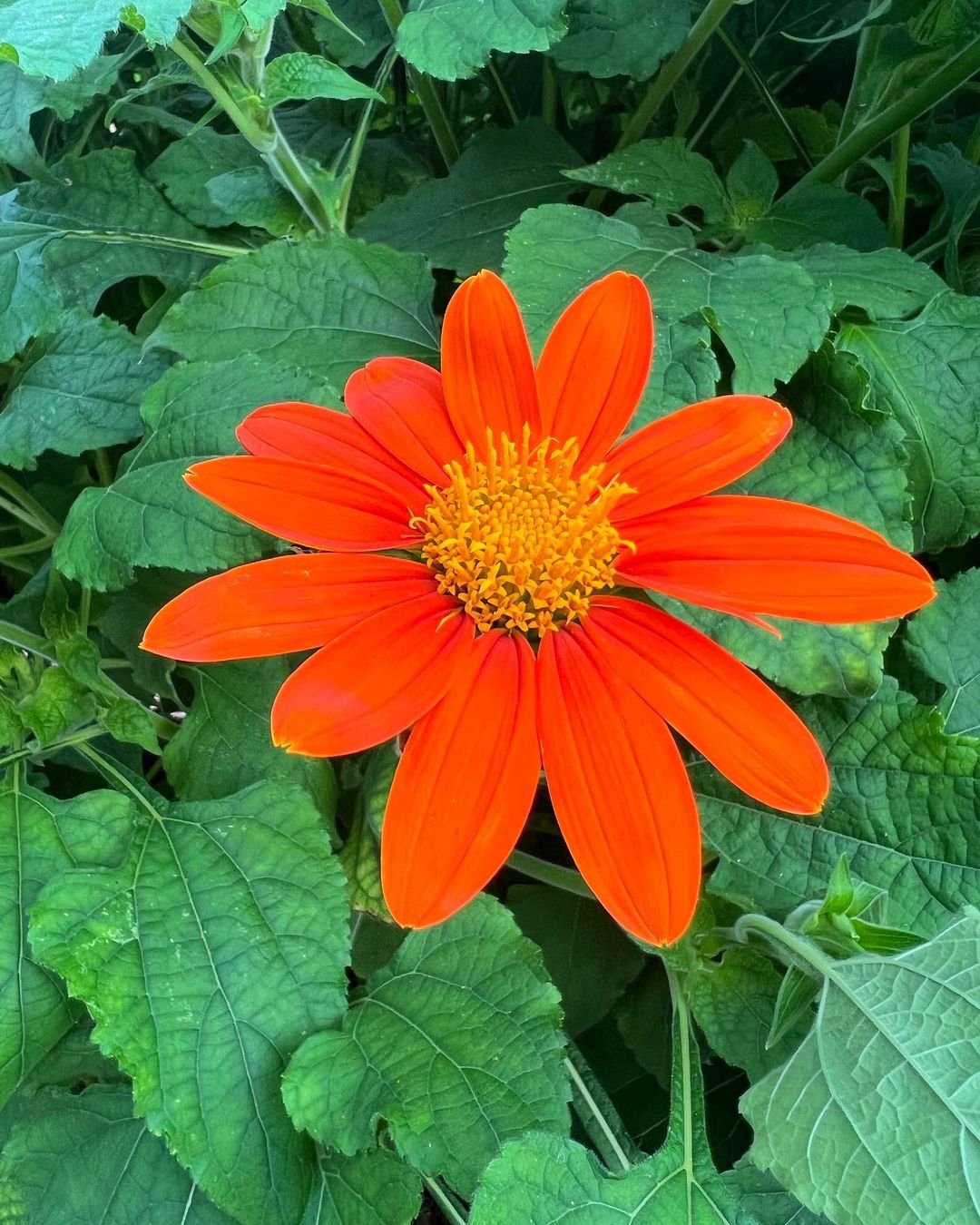
Here’s a short information chart for Mexican Sunflower (Tithonia rotundifolia):
| Aspect | Information |
|---|---|
| Botanical Name | Tithonia rotundifolia |
| Common Name | Mexican Sunflower |
| Plant Type | Annual |
| Family | Asteraceae |
| Native Range | Mexico, Central America |
| Zones | Typically grown as annuals, suitable for zones 2-11 |
| Flowers | Large, daisy-like flowers in bright orange or red |
| Sun Exposure | Full sun |
| Soil Type | Well-drained, fertile soil |
| Watering | Moderate; drought tolerant once established |
| Growth Habit | Upright, bushy |
| Height/Spread | 4 to 6 feet tall, 2 to 3 feet wide |
| Special Features | Attracts butterflies and bees, deer resistant, drought tolerant |
The Mexican Sunflower produces large, daisy-like flowers on tall stems. It’s a magnet for butterflies and hummingbirds.
22. Oriental Poppy
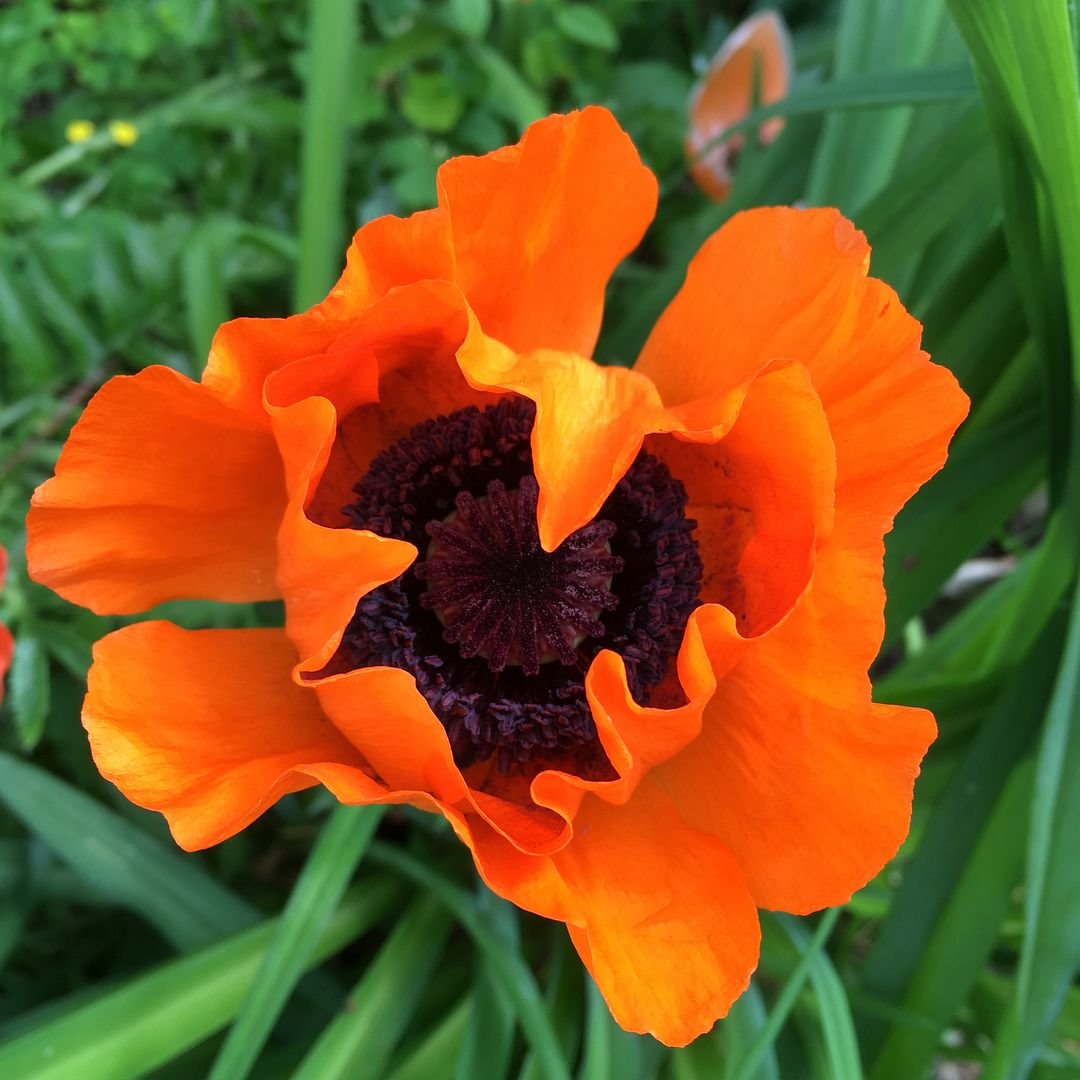
Here’s a short information chart for Oriental Poppy (Papaver orientale):
| Aspect | Information |
|---|---|
| Botanical Name | Papaver orientale |
| Common Name | Oriental Poppy |
| Plant Type | Herbaceous perennial |
| Family | Papaveraceae |
| Native Range | Asia Minor, Caucasus, Iran |
| Zones | Typically zones 3-7 |
| Flowers | Large, cup-shaped flowers in various colors (red, orange, pink) |
| Sun Exposure | Full sun |
| Soil Type | Well-drained, fertile soil |
| Watering | Moderate; drought tolerant once established |
| Growth Habit | Clump-forming, upright |
| Height/Spread | 2 to 4 feet tall, 1 to 2 feet wide |
| Special Features | Showy flowers, deer resistant, attractive to pollinators |
The Oriental Poppy produces large, silky flowers with dark centers. It’s a stunning addition to any perennial border.
23. Portulaca
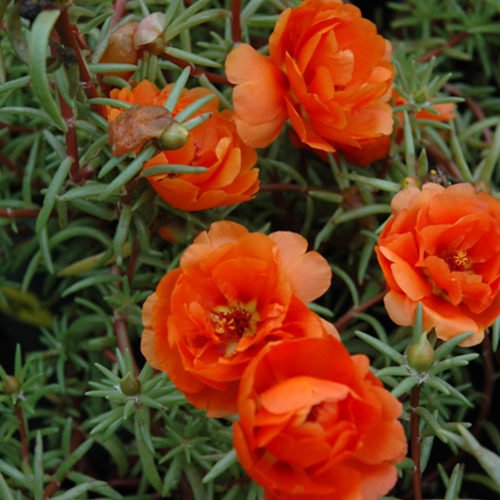
Here’s a short information chart for Portulaca (Portulaca grandiflora):
| Aspect | Information |
|---|---|
| Botanical Name | Portulaca grandiflora |
| Common Name | Portulaca, Moss Rose |
| Plant Type | Annual succulent |
| Family | Portulacaceae |
| Native Range | South America |
| Zones | Typically grown as annuals, suitable for zones 2-11 |
| Flowers | Small, rose-like flowers in various colors (pink, red, yellow, white) |
| Sun Exposure | Full sun |
| Soil Type | Well-drained, sandy soil |
| Watering | Low; drought tolerant |
| Growth Habit | Spreading, mat-forming |
| Height/Spread | 4 to 8 inches tall, 6 to 12 inches wide |
| Special Features | Heat tolerant, blooms all summer, suitable for containers |
Also known as moss rose, Portulaca is a low-growing annual that produces masses of small, rose-like flowers in various shades, including orange.
24. Tulip
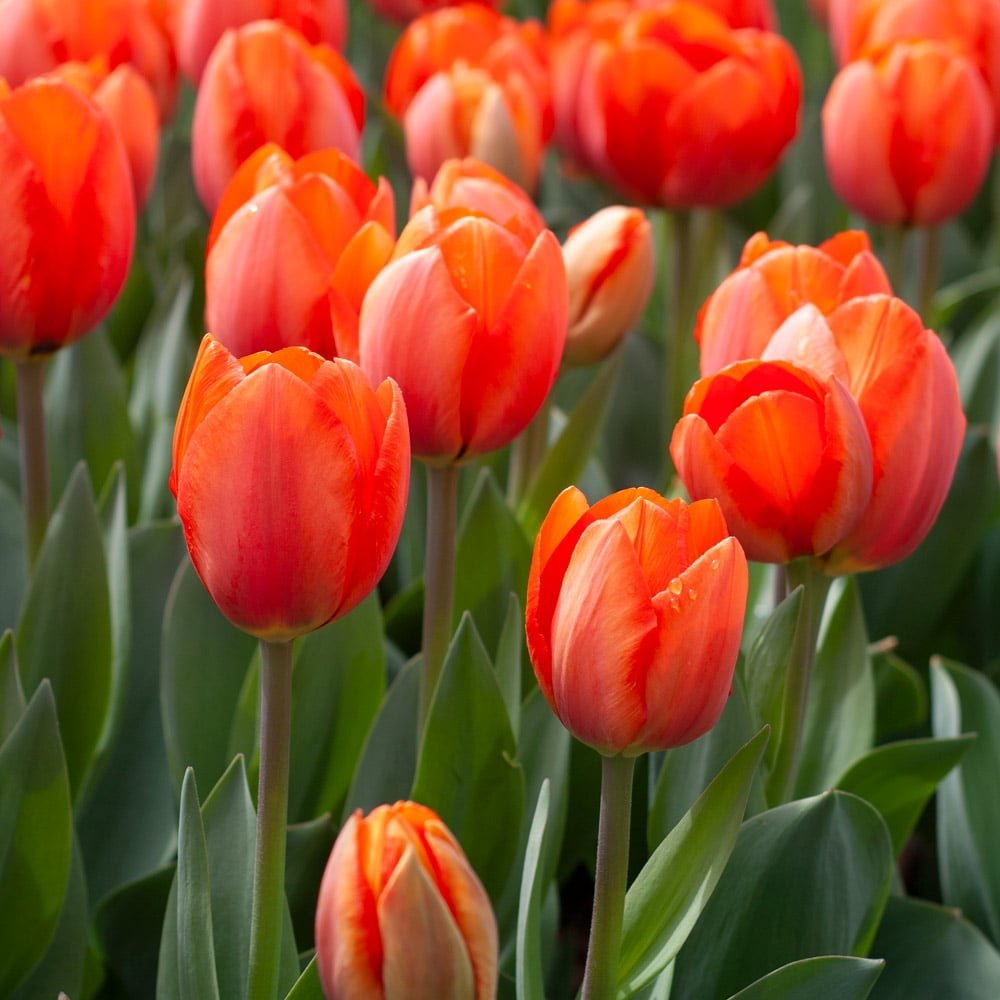
ere’s a short information chart for Tulip (Tulipa spp.):
| Aspect | Information |
|---|---|
| Botanical Name | Tulipa spp. |
| Common Name | Tulip |
| Plant Type | Bulbous perennial |
| Family | Liliaceae |
| Native Range | Central Asia, Turkey, Iran |
| Zones | Typically zones 3-8 |
| Flowers | Cup-shaped flowers in various colors (red, yellow, pink, orange, purple, white) |
| Sun Exposure | Full sun to part shade |
| Soil Type | Well-drained, fertile soil |
| Watering | Moderate; keep soil evenly moist |
| Growth Habit | Upright, stem with single flower |
| Height/Spread | 6 inches to 2 feet tall, 4 to 6 inches wide |
| Special Features | Early spring bloomer, excellent cut flowers, deer resistant |
Many Tulip varieties offer beautiful orange blooms. These spring-flowering bulbs are perfect for adding early color to your garden.
25. Alstroemeria
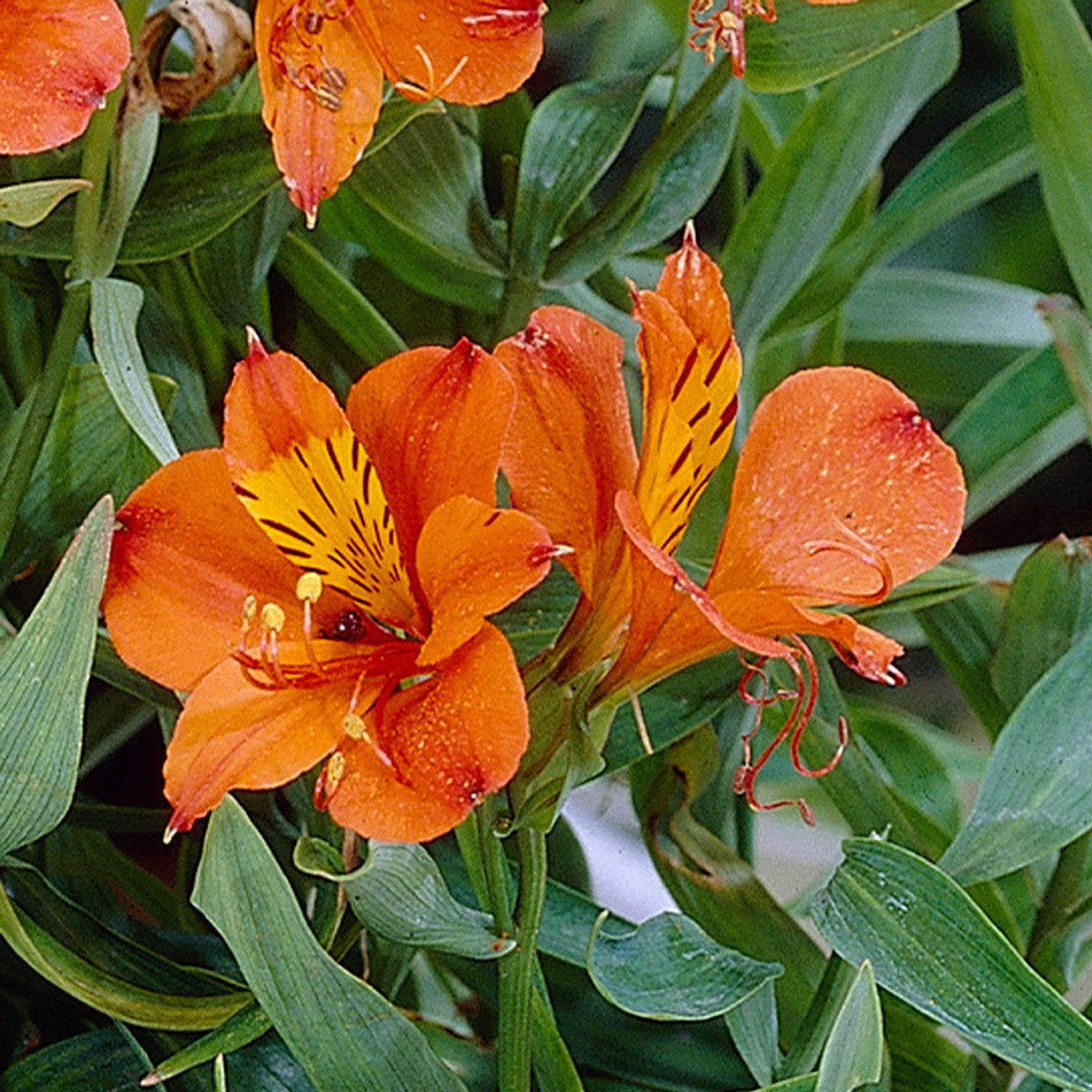
Here’s a short information chart for Alstroemeria (Alstroemeria aurantiaca):
| Aspect | Information |
|---|---|
| Botanical Name | Alstroemeria aurantiaca |
| Common Name | Alstroemeria, Peruvian Lily |
| Plant Type | Herbaceous perennial |
| Family | Alstroemeriaceae |
| Native Range | South America |
| Zones | Typically zones 7-10, can be grown as annuals in colder zones |
| Flowers | Trumpet-shaped flowers in various colors (orange, pink, yellow, white) |
| Sun Exposure | Full sun to part shade |
| Soil Type | Well-drained, fertile soil |
| Watering | Moderate; keep soil evenly moist |
| Growth Habit | Upright, clumping |
| Height/Spread | 1 to 3 feet tall, 1 to 2 feet wide |
| Special Features | Long-lasting cut flowers, attracts butterflies, deer resistant |
The orange variety of Alstroemeria, also known as Peruvian Lily, produces clusters of lily-like flowers that are excellent for cutting.
26. Torch Lily
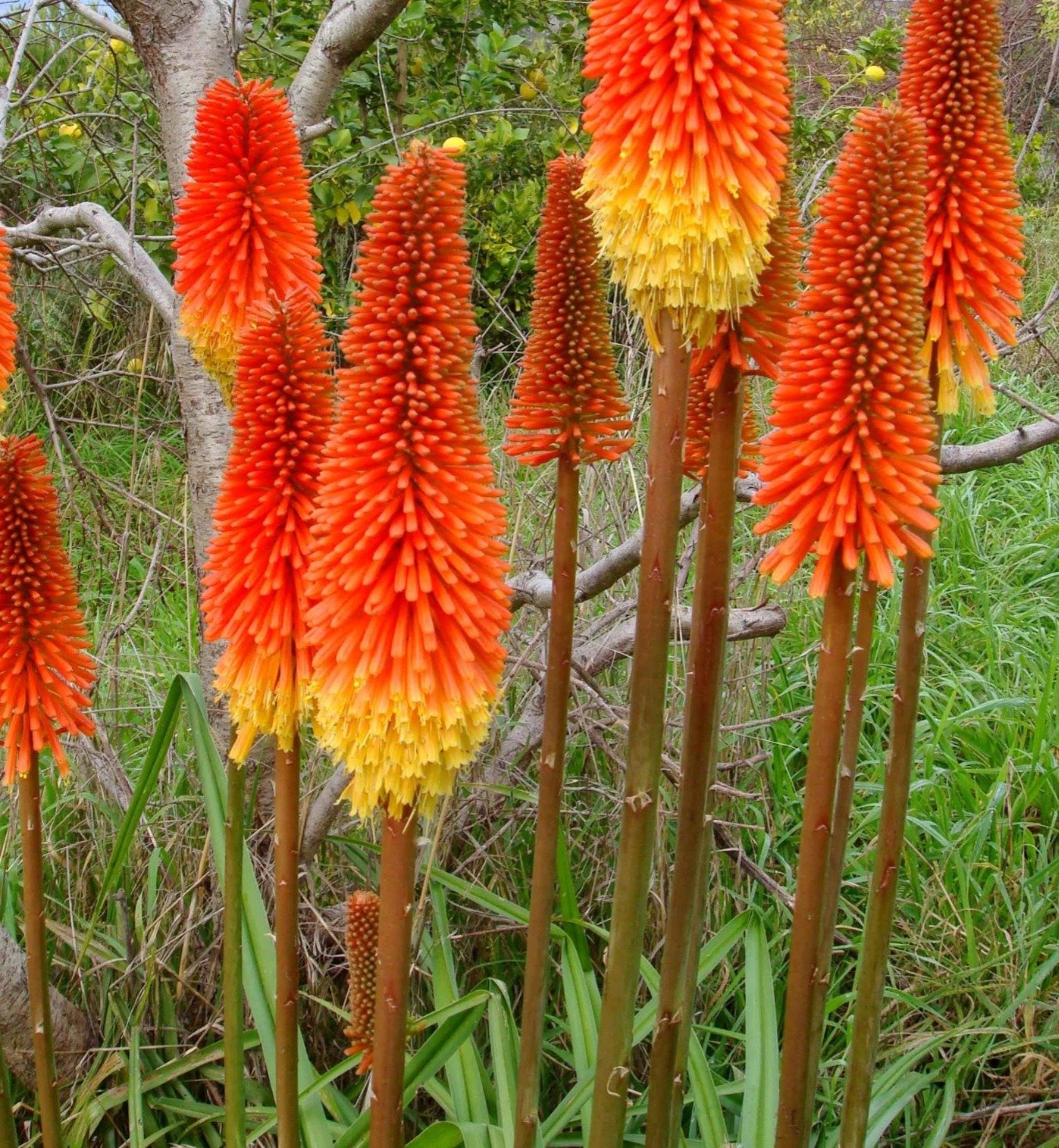
Here’s a short information chart for Torch Lily (Kniphofia spp.):
| Aspect | Information |
|---|---|
| Botanical Name | Kniphofia spp. |
| Common Name | Torch Lily, Red Hot Poker |
| Plant Type | Herbaceous perennial |
| Family | Asphodelaceae |
| Native Range | Southern and eastern Africa |
| Zones | Typically zones 5-9 |
| Flowers | Spikes of tubular flowers in shades of red, orange, yellow, or creamy white |
| Sun Exposure | Full sun |
| Soil Type | Well-drained, fertile soil |
| Watering | Moderate; drought tolerant once established |
| Growth Habit | Upright, clumping |
| Height/Spread | 2 to 5 feet tall, 1 to 3 feet wide |
| Special Features | Attracts hummingbirds, deer resistant, striking architectural presence |
Also known as Red Hot Poker, Torch Lily features tall spikes of tubular flowers in shades of orange and yellow.
27. Gerbera Daisy

Here’s a short information chart for Gerbera Daisy (Gerbera jamesonii):
| Aspect | Information |
|---|---|
| Botanical Name | Gerbera jamesonii |
| Common Name | Gerbera Daisy |
| Plant Type | Herbaceous perennial |
| Family | Asteraceae |
| Native Range | South Africa |
| Zones | Typically grown as annuals or in zones 8-11 |
| Flowers | Large, daisy-like flowers in various colors (pink, red, yellow, orange, white) |
| Sun Exposure | Full sun to part shade |
| Soil Type | Well-drained, fertile soil |
| Watering | Regular; keep soil evenly moist |
| Growth Habit | Clumping, basal rosette |
| Height/Spread | 6 to 18 inches tall, 12 to 18 inches wide |
| Special Features | Long-lasting cut flowers, attractive to pollinators, deer resistant |
Gerbera Daisies come in a range of colors, including vibrant orange. Their large, cheerful blooms are perfect for containers or cutting gardens.
28. Wallflower
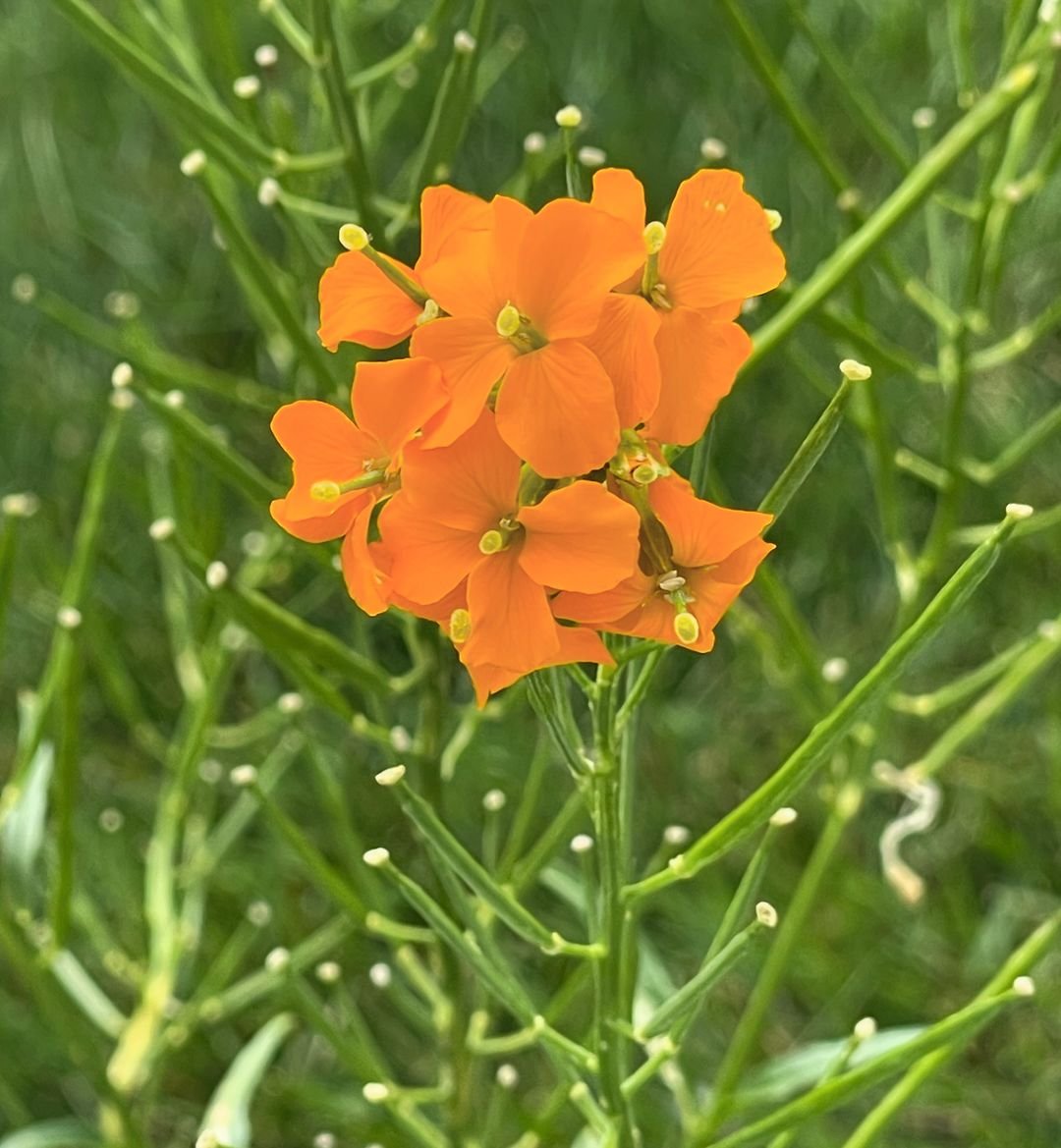
Here’s a short information chart for Wallflower (Erysimum spp.):
| Aspect | Information |
|---|---|
| Botanical Name | Erysimum spp. |
| Common Name | Wallflower |
| Plant Type | Herbaceous perennial or biennial |
| Family | Brassicaceae |
| Native Range | Europe, Asia, North Africa |
| Zones | Typically zones 5-9 |
| Flowers | Clusters of small, fragrant flowers in various colors (yellow, orange, purple, red) |
| Sun Exposure | Full sun to part shade |
| Soil Type | Well-drained, fertile soil |
| Watering | Moderate; prefers evenly moist soil |
| Growth Habit | Upright, bushy |
| Height/Spread | 6 inches to 3 feet tall, 6 inches to 2 feet wide |
| Special Features | Fragrant flowers, attracts butterflies, deer resistant |
Some Wallflower varieties offer beautiful orange blooms. These fragrant flowers are great for attracting pollinators.
29. Chrysanthemum
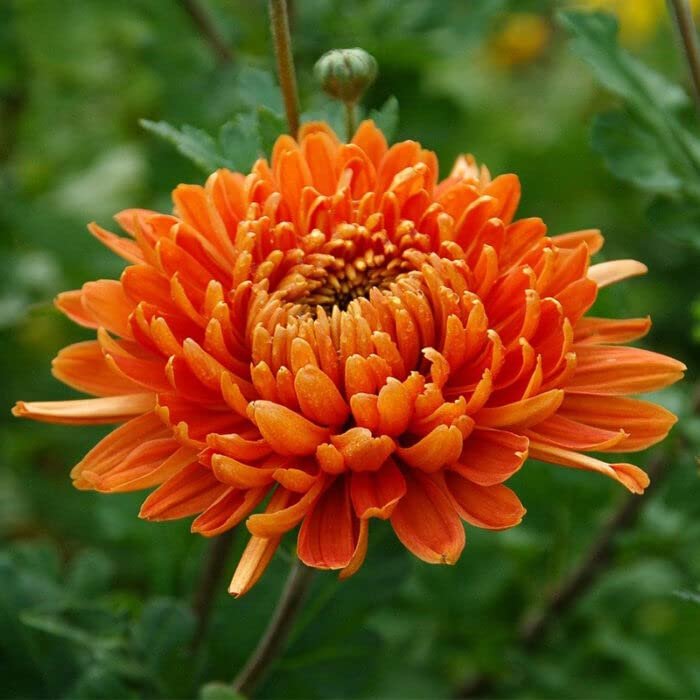
Here’s a short information chart for Chrysanthemum (Chrysanthemum spp.):
| Aspect | Information |
|---|---|
| Botanical Name | Chrysanthemum spp. |
| Common Name | Chrysanthemum, Mum |
| Plant Type | Herbaceous perennial |
| Family | Asteraceae |
| Native Range | Asia and northeastern Europe |
| Zones | Typically zones 5-9 |
| Flowers | Daisy-like flowers in various forms and colors (white, orange, yellow, pink, red, purple) |
| Sun Exposure | Full sun to part shade |
| Soil Type | Well-drained, fertile soil |
| Watering | Regular; keep soil evenly moist |
| Growth Habit | Upright, bushy |
| Height/Spread | 1 to 3 feet tall, 1 to 2 feet wide |
| Special Features | Long-lasting cut flowers, attracts butterflies, deer resistant |
Many Chrysanthemum varieties come in shades of orange. These fall-blooming perennials add late-season color to the garden.
30. Trollius
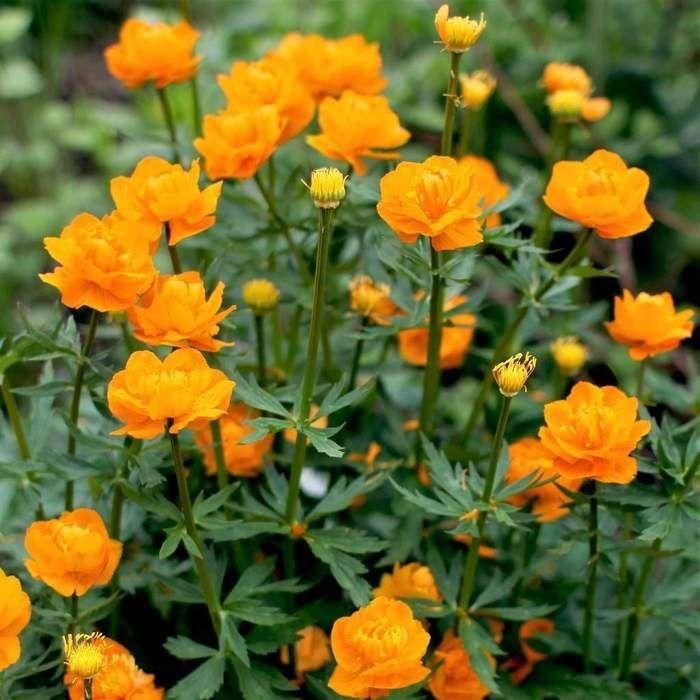
Here’s a short information chart for Trollius (Trollius spp.):
| Aspect | Information |
|---|---|
| Botanical Name | Trollius spp. |
| Common Name | Globe Flower |
| Plant Type | Herbaceous perennial |
| Family | Ranunculaceae |
| Native Range | Northern Hemisphere, including Europe, Asia, North America |
| Zones | Typically zones 3-7 |
| Flowers | Globular flowers in shades of yellow, orange, or cream |
| Sun Exposure | Full sun to part shade |
| Soil Type | Moist, fertile soil |
| Watering | Regular; prefers consistently moist soil |
| Growth Habit | Upright, clumping |
| Height/Spread | 1 to 3 feet tall, 1 to 2 feet wide |
| Special Features | Attracts pollinators, deer resistant, cottage garden favorite |
Also known as Globeflower, Trollius produces globe-shaped flowers above attractive, deeply-lobed foliage.
31. Amaryllis
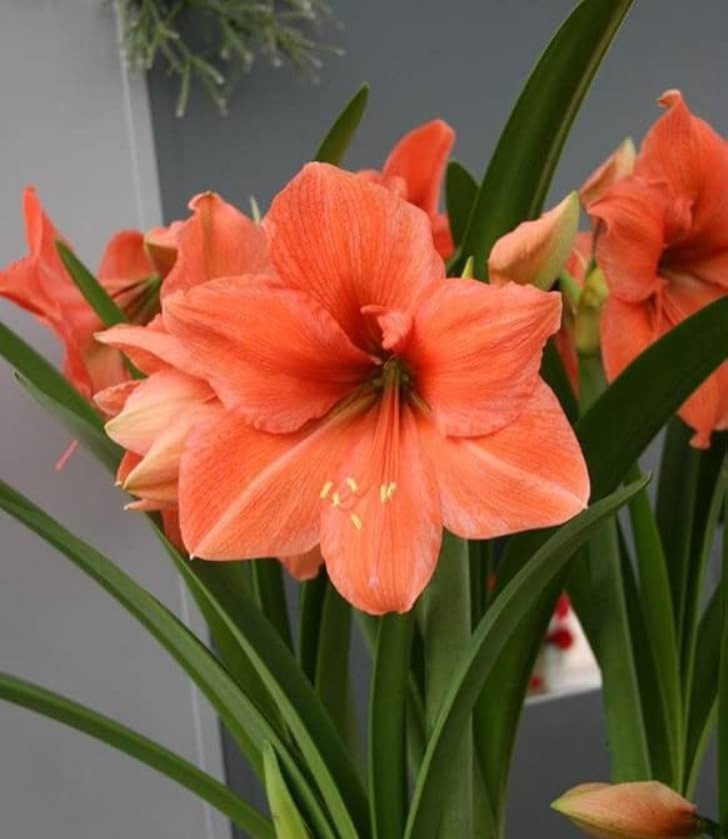
Here’s a short information chart for Amaryllis (Hippeastrum spp.):
| Aspect | Information |
|---|---|
| Botanical Name | Hippeastrum spp. |
| Common Name | Amaryllis |
| Plant Type | Bulbous perennial |
| Family | Amaryllidaceae |
| Native Range | Central and South America |
| Zones | Typically grown indoors, suitable for zones 8-11 outdoors |
| Flowers | Large, trumpet-shaped flowers in various colors (red, pink, white, orange) |
| Sun Exposure | Bright indirect light to full sun |
| Soil Type | Well-drained, fertile soil |
| Watering | Moderate; allow soil to dry slightly between waterings |
| Growth Habit | Upright, leafy |
| Height/Spread | 1 to 2 feet tall, 1 to 1.5 feet wide |
| Special Features | Indoor plant, stunning flowers, easy to grow from bulbs |
While often grown as indoor plants, some Amaryllis varieties can be grown outdoors in warm climates. They offer large, trumpet-shaped flowers.
32. Hibiscus
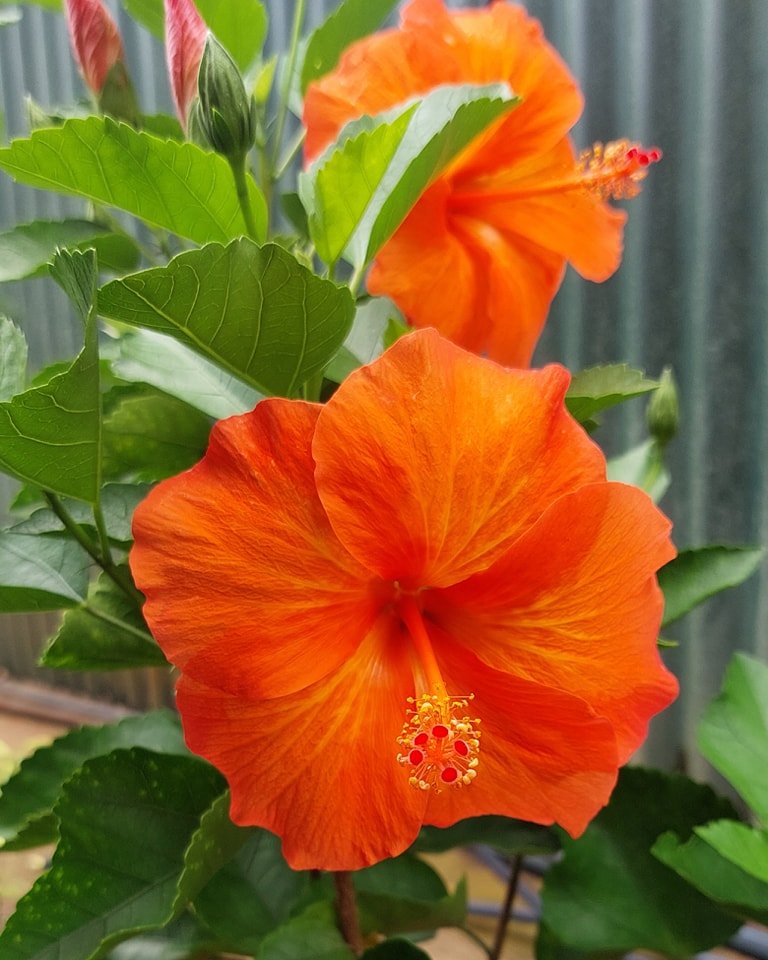
Here’s a short information chart for Hibiscus (Hibiscus spp.):
| Aspect | Information |
|---|---|
| Botanical Name | Hibiscus spp. |
| Common Name | Hibiscus |
| Plant Type | Shrubs or small trees (depending on species) |
| Family | Malvaceae |
| Native Range | Tropical and subtropical regions worldwide |
| Zones | Varies by species; generally zones 4-11 |
| Flowers | Large, showy flowers in various colors (red, pink, yellow, white) |
| Sun Exposure | Full sun to part shade |
| Soil Type | Well-drained, fertile soil |
| Watering | Moderate; keep soil evenly moist |
| Growth Habit | Bushy, upright |
| Height/Spread | Varies widely by species; from a few feet to over 10 feet tall and wide |
| Special Features | Attracts pollinators, tropical appearance, can be grown as perennial or annual depending on climate |
Some Hibiscus varieties produce stunning flowers. These tropical-looking plants add a touch of exotic beauty to the garden.
33. Honeysuckle
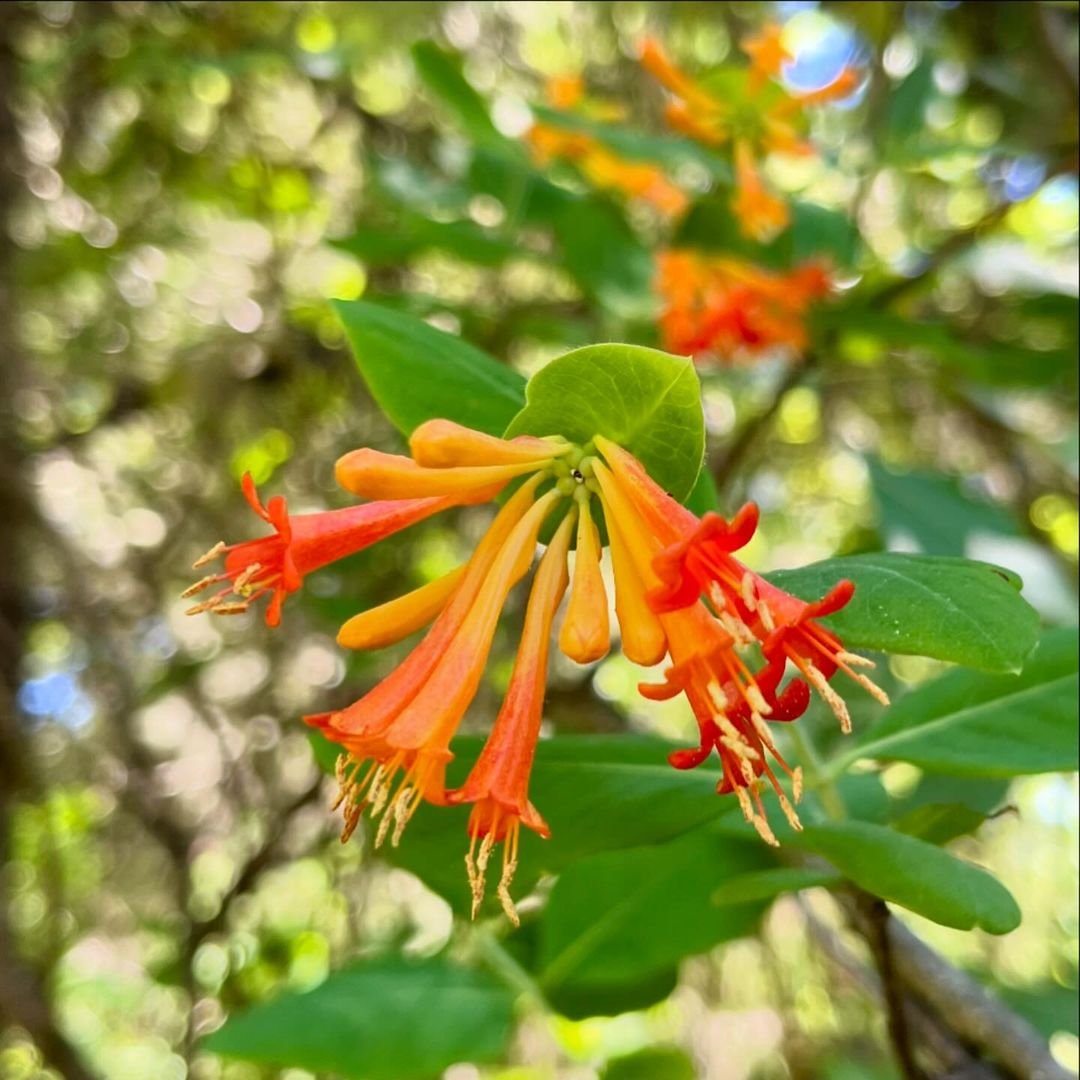
Here’s a short information chart for Honeysuckle (Lonicera spp.):
| Aspect | Information |
|---|---|
| Botanical Name | Lonicera spp. |
| Common Name | Honeysuckle |
| Plant Type | Climbing vine or shrub |
| Family | Caprifoliaceae |
| Native Range | Worldwide, with most species native to the Northern Hemisphere |
| Zones | Varies by species; typically zones 4-9 |
| Flowers | Fragrant, tubular flowers in various colors (white, yellow, pink, orange) |
| Sun Exposure | Full sun to part shade |
| Soil Type | Well-drained, fertile soil |
| Watering | Regular; keep soil evenly moist |
| Growth Habit | Climbing or spreading |
| Height/Spread | Varies widely by species; from a few feet to over 20 feet tall and wide |
| Special Features | Fragrant flowers, attracts hummingbirds and butterflies, some species are invasive |
Certain Honeysuckle varieties offer tubular flowers that are irresistible to hummingbirds.
34. Leonotis
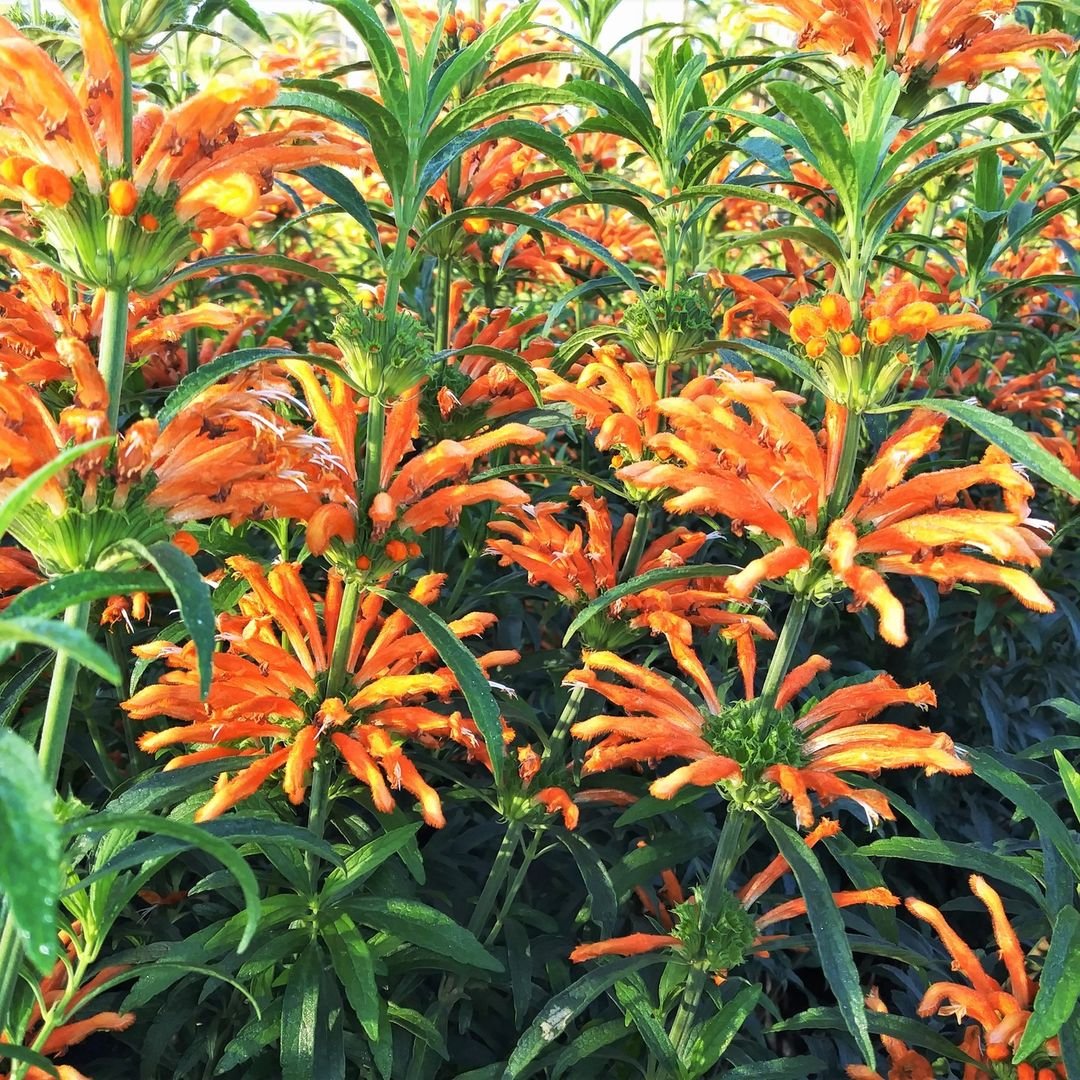
Here’s a short information chart for Leonotis (Leonotis leonurus):
| Aspect | Information |
|---|---|
| Botanical Name | Leonotis leonurus |
| Common Name | Lion’s Tail, Wild Dagga |
| Plant Type | Herbaceous perennial |
| Family | Lamiaceae (Mint family) |
| Native Range | Southern Africa |
| Zones | Typically zones 8-11, often grown as an annual in cooler climates |
| Flowers | Whorls of tubular orange |
| Sun Exposure | Full sun to partial shade |
| Soil Type | Well-drained, sandy soil |
| Watering | Moderate; drought tolerant once established |
| Growth Habit | Upright, clumping |
| Height/Spread | 3 to 6 feet tall, 2 to 3 feet wide |
| Special Features | Attracts hummingbirds and butterflies, deer resistant, medicinal uses in traditional medicine |
Also known as Lion’s Tail, Leonotis produces whorls of fuzzy flowers along tall stems.
35. Ranunculus
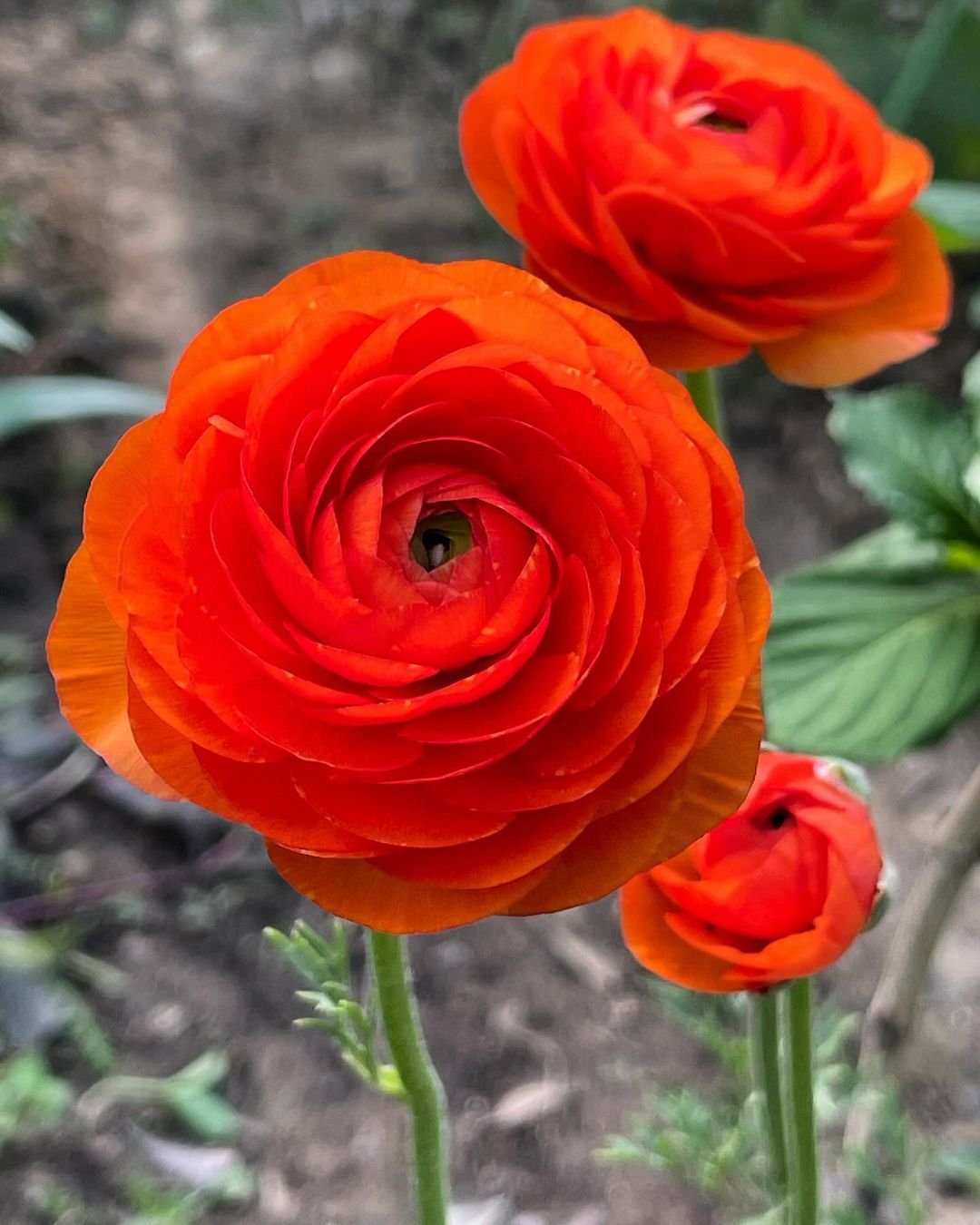
Here’s a short information chart for Ranunculus (Ranunculus asiaticus):
| Aspect | Information |
|---|---|
| Botanical Name | Ranunculus asiaticus |
| Common Name | Persian Buttercup |
| Plant Type | Herbaceous perennial |
| Family | Ranunculaceae |
| Native Range | Mediterranean region |
| Zones | Typically zones 8-11, grown as annuals in cooler climates |
| Flowers | Showy, rose-like flowers in various colors (red, pink, yellow, orange, white) |
| Sun Exposure | Full sun to part shade |
| Soil Type | Well-drained, fertile soil |
| Watering | Regular; keep soil evenly moist |
| Growth Habit | Clumping, low-growing |
| Height/Spread | 6 to 12 inches tall, 6 to 9 inches wide |
| Special Features | Excellent cut flowers, deer resistant, early spring bloomer |
Ranunculus produces rose-like flowers in various colors, including vibrant orange. They’re excellent for cutting gardens.
36. Snapdragon
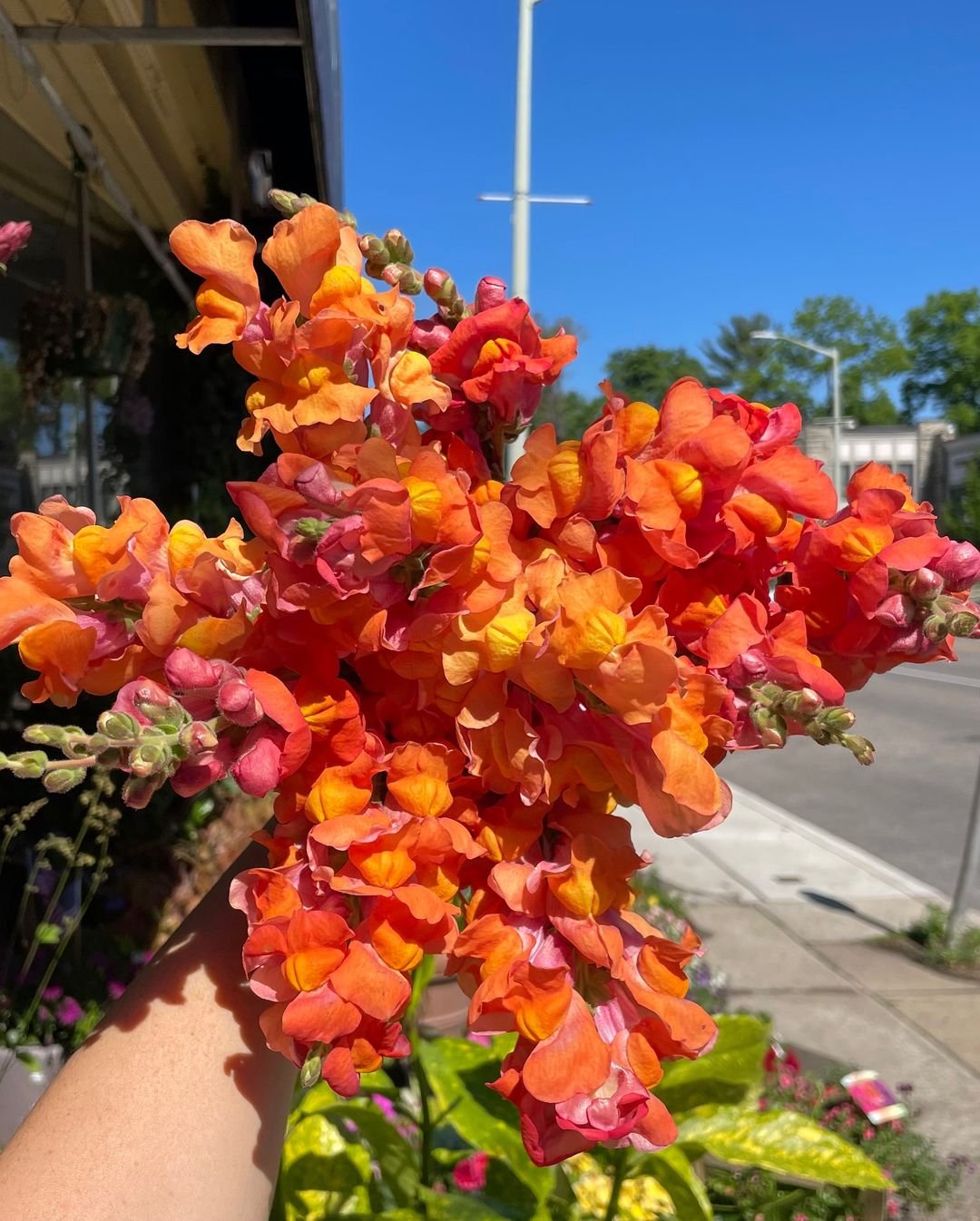
Here’s a short information chart for Snapdragon (Antirrhinum majus):
| Aspect | Information |
|---|---|
| Botanical Name | Antirrhinum majus |
| Common Name | Snapdragon |
| Plant Type | Herbaceous annual or perennial depending on climate |
| Family | Plantaginaceae |
| Native Range | Mediterranean region, North America |
| Zones | Typically zones 7-10, grown as annuals in cooler climates |
| Flowers | Spikes of colorful, snapdragon-shaped flowers in various colors (pink, red, yellow, orange, white) |
| Sun Exposure | Full sun to part shade |
| Soil Type | Well-drained, fertile soil |
| Watering | Moderate; keep soil evenly moist |
| Growth Habit | Upright, bushy |
| Height/Spread | 6 inches to 3 feet tall, 6 to 12 inches wide |
| Special Features | Attracts pollinators, deer resistant, good for cutting gardens |
Many Snapdragon varieties come in shades of orange. These vertical bloomers add height and color to garden beds.
37. Witch Hazel
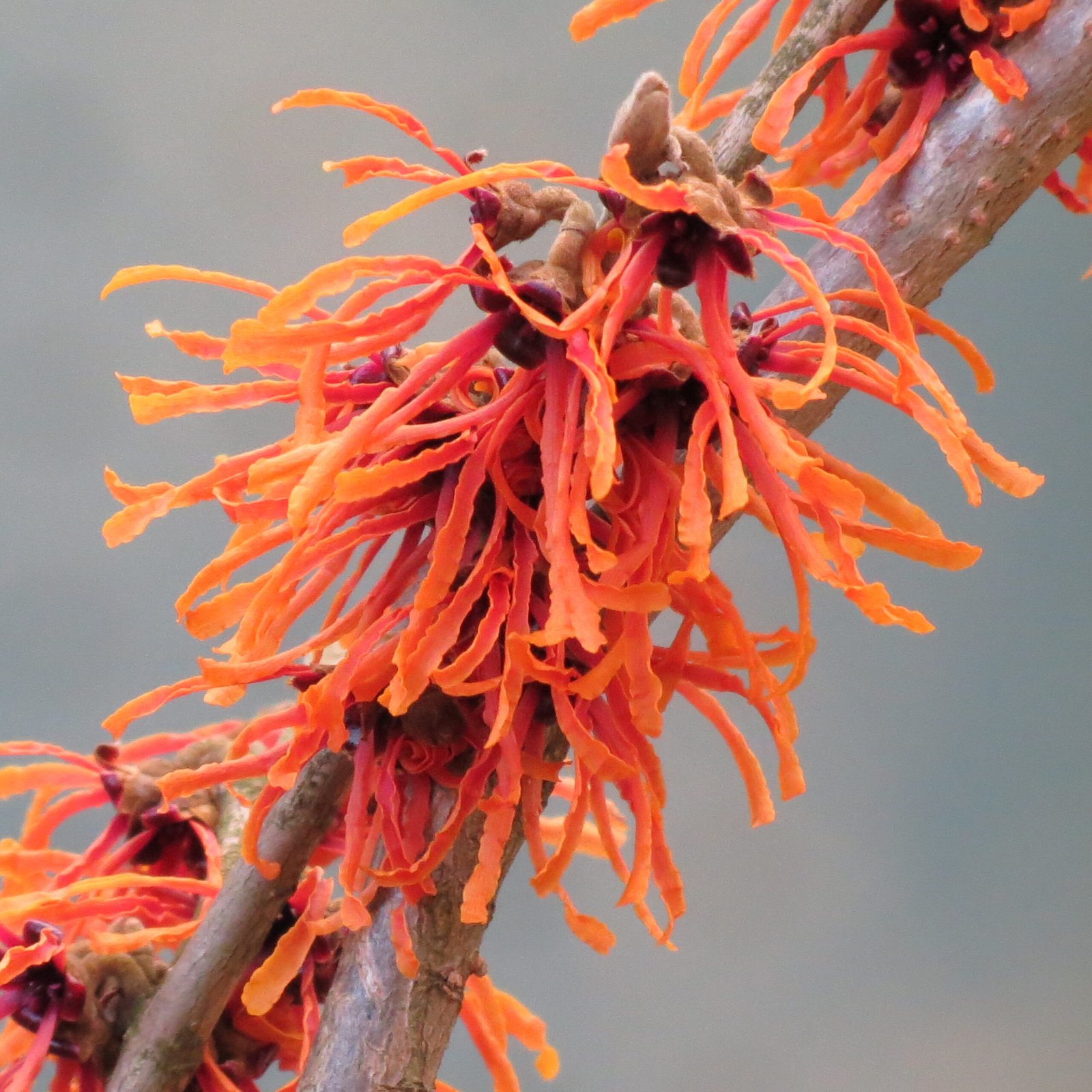
Here’s a short information chart for Witch Hazel (Hamamelis x intermedia ‘Jelena’):
| Aspect | Information |
|---|---|
| Botanical Name | Hamamelis x intermedia ‘Jelena’ |
| Common Name | Witch Hazel |
| Plant Type | Deciduous shrub |
| Family | Hamamelidaceae |
| Native Range | Hybrid of Asian and North American species |
| Zones | Typically zones 5-8 |
| Flowers | Spidery, fragrant flowers in shades of orange and red |
| Sun Exposure | Full sun to part shade |
| Soil Type | Moist, well-drained soil |
| Watering | Regular; prefers consistently moist soil |
| Growth Habit | Upright, spreading |
| Height/Spread | 10 to 15 feet tall, 10 to 12 feet wide |
| Special Features | Fragrant winter blooms, fall foliage color, deer resistant |
The ‘Jelena’ variety of Witch Hazel offers coppery- flowers that bloom in late winter, adding color when most gardens are still dormant.
38. Echinacea
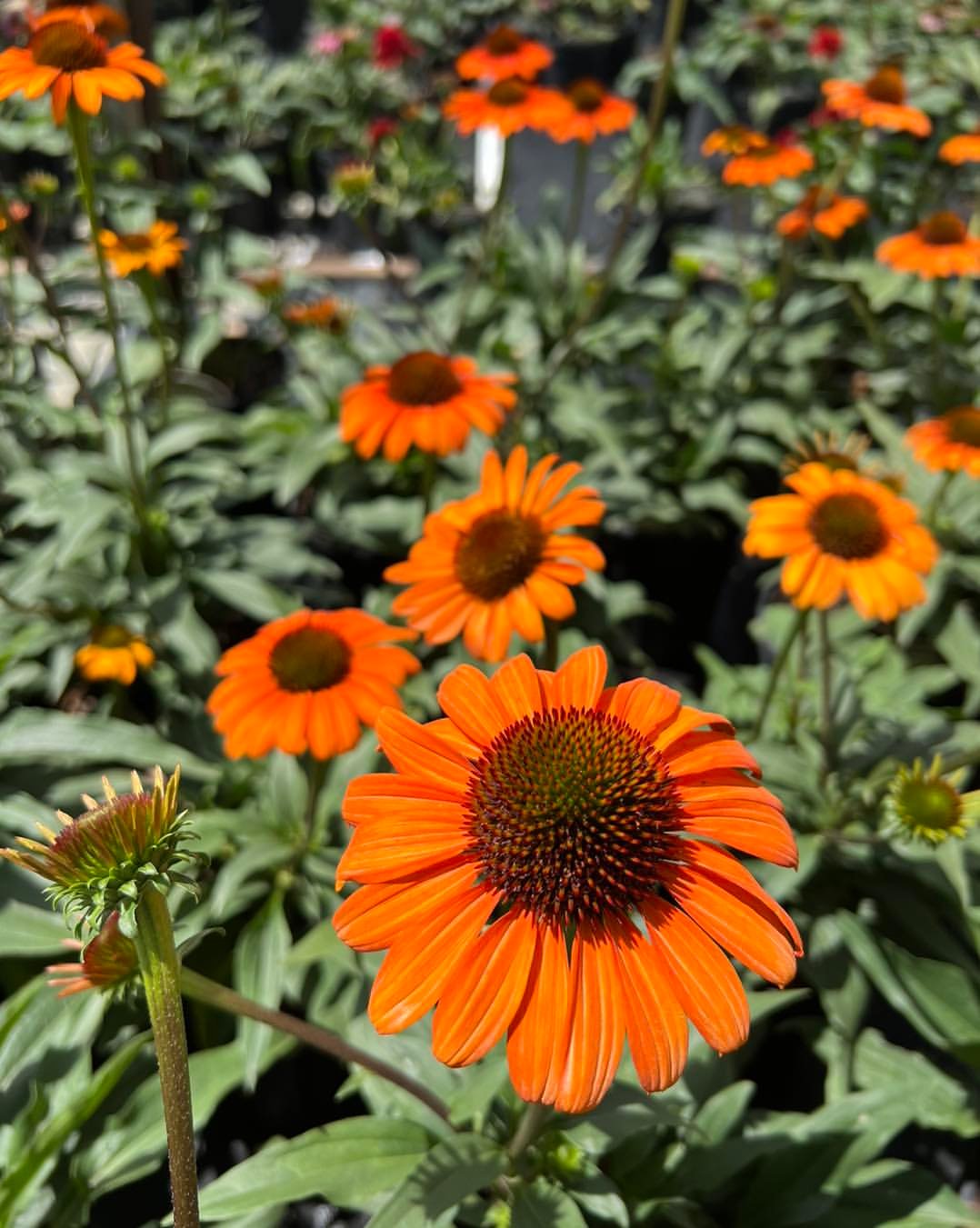
Here’s a short information chart for Echinacea ‘Tiki Torch’ (Echinacea):
| Aspect | Information |
|---|---|
| Botanical Name | Echinacea purpurea ‘Tiki Torch’ |
| Common Name | Coneflower, Echinacea |
| Plant Type | Herbaceous perennial |
| Family | Asteraceae |
| Native Range | North America |
| Zones | Typically zones 3-9 |
| Flowers | Large, daisy-like flowers with deep orange-red petals and a prominent cone |
| Sun Exposure | Full sun |
| Soil Type | Well-drained, fertile soil |
| Watering | Moderate; drought tolerant once established |
| Growth Habit | Upright, clumping |
| Height/Spread | 2 to 3 feet tall, 1 to 2 feet wide |
| Special Features | Attracts pollinators, deer resistant, long-lasting cut flowers |
Rounding out our list is another Echinacea variety. ‘Tiki Torch’ offers vibrant orange petals around a prominent central cone.
Planting and Care Tips for Orange Flowers
To ensure your flowers thrive and create a stunning display, consider these general tips:
- Sunlight: Most flowers prefer full sun, which means at least 6 hours of direct sunlight daily. However, some, like Impatiens, prefer partial shade.
- Soil: Well-draining soil is crucial for most plants. Amend heavy clay soils with organic matter to improve drainage.
- Water: Water needs vary by plant, but most prefer consistent moisture without waterlogging. Use mulch to help retain soil moisture.
- Fertilizer: Apply a balanced, slow-release fertilizer in spring to promote healthy growth and abundant blooms.
- Deadheading: Remove spent blooms regularly to encourage continued flowering and maintain a tidy appearance.
- Winter care: For perennials, apply a layer of mulch in fall to protect roots from freezing temperatures.
Designing with Orange Flowers
Orange is a bold color that can make a strong statement in your garden. Here are some design tips:
- Contrast: Pair orange flowers with purple or blue blooms for a striking contrast.
- Harmony: Combine orange flowers with yellow and red blooms for a harmonious, warm color scheme.
- Focal points: Use large orange flowers like dahlias or canna lilies as focal points in garden beds.
- Containers: Plant orange annuals in containers for portable pops of color around your garden or patio.
- Wildflower meadows: Incorporate orange wildflowers like California Poppies or Blanket Flowers into naturalistic plantings.
Incorporating flowers into your garden can truly transform your outdoor space, adding warmth, energy and vibrant beauty. From the familiar marigold to the exotic bird of paradise, there’s an orange flower to suit every garden style and growing condition. By choosing a variety of plants that bloom at different times, you can ensure a continuous display of orange throughout the growing season.
Remember, the key to success with any plant is providing the right growing conditions and consistent care. With a little attention and these 38 stunning orange flowers at your disposal, you’ll be well on your way to creating a garden that glows with the warmth and vitality of a summer sunset. So go ahead, embrace the bold beauty of flowers and watch as they bring new life and energy to your garden!

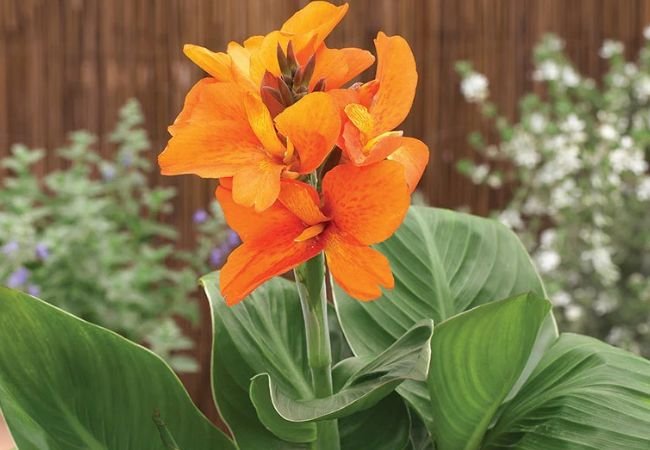

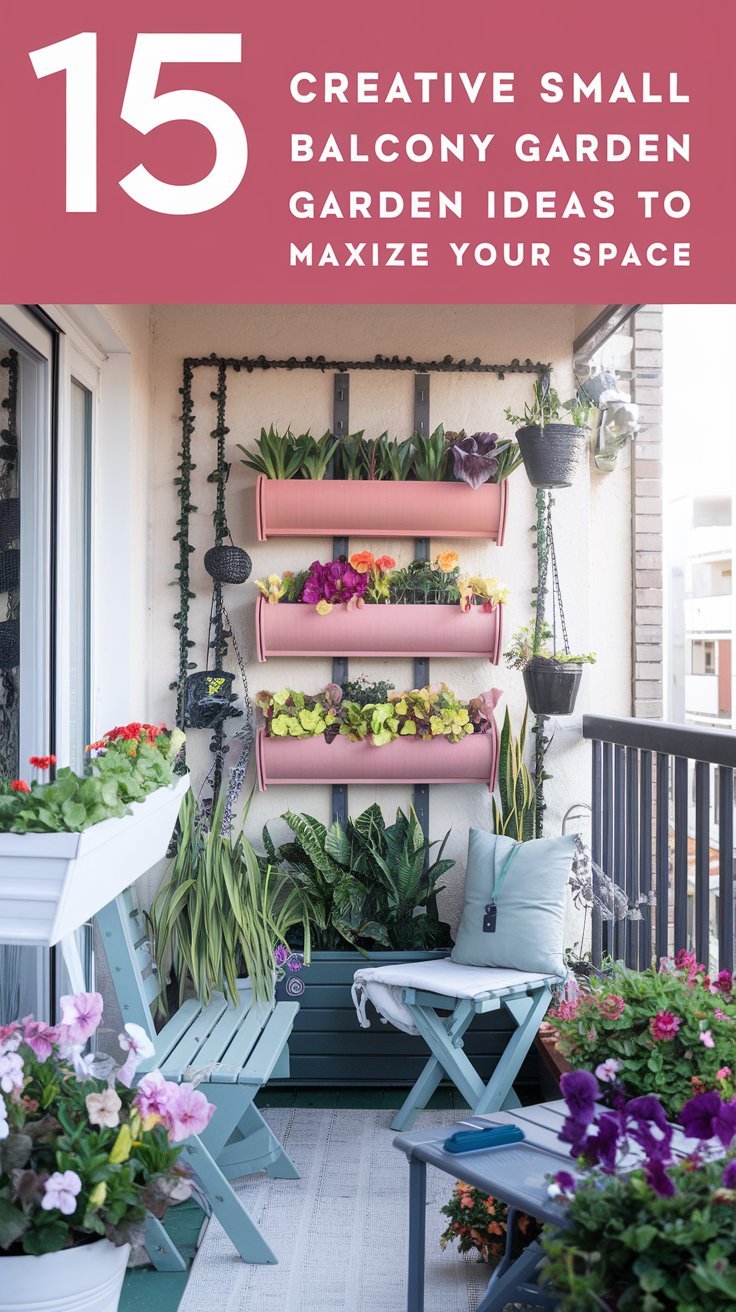




Leave a Reply